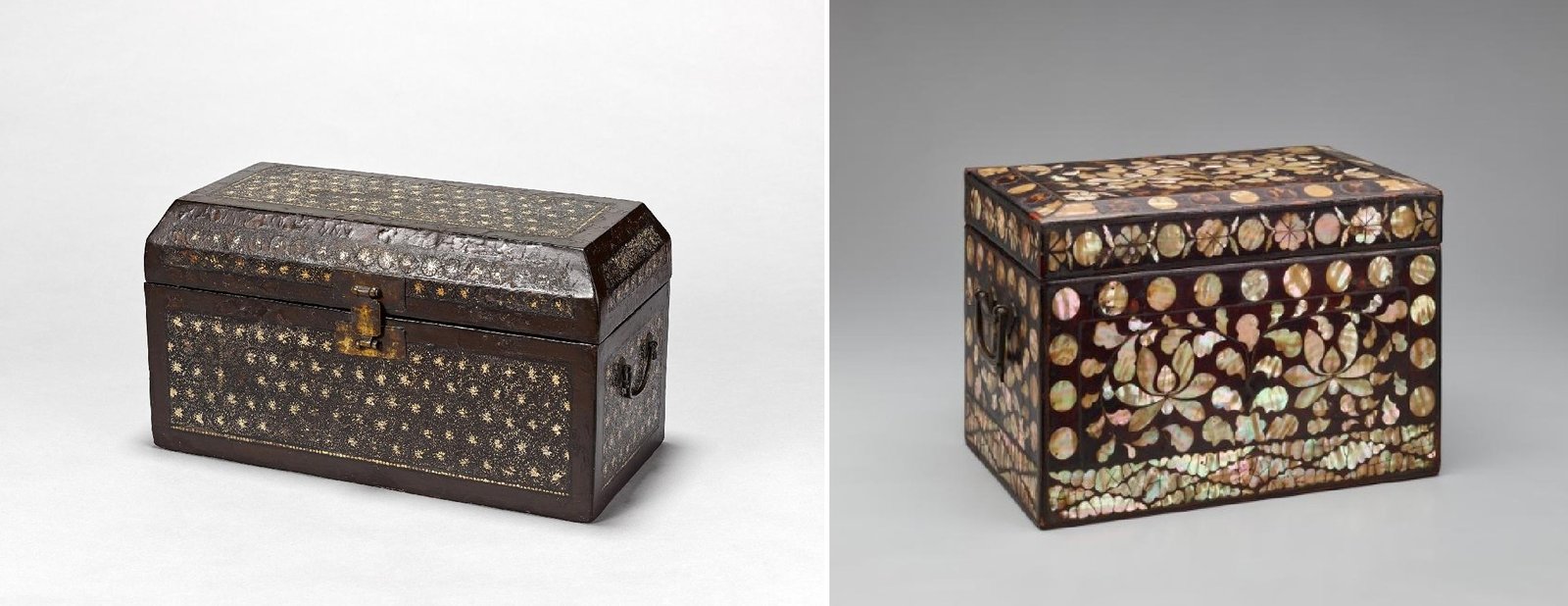Korean lacquer has already been the subject of publications on this site. You can consult them at the following links:
- https://www.koreanantiquefurniture.com/the-art-of-korean-lacquer/
- https://www.koreanantiquefurniture.com/korean-mother-of-pearl-inlay-lacquer-ware/
In this new article, we attempt to explore the main differences between the techniques and decorative motifs used during the Goryeo and Joseon dynasties.
Here are some famous mother-of-pearl inlay (Najeonchilgi) artifacts from the Goryeo and Joseon dynasties, showcasing the differences in style and craftsmanship.
Goryeo Dynasty (918–1392)
Goryeo (Korean: 고려; Hanja: 高麗) was a Korean state founded in 918, during a time of national division called the Later Three Kingdoms period, that unified and ruled the Korean Peninsula until the establishment of Joseon in 1392. The name “Korea” is derived from the name of Goryeo, also romanized as Koryŏ. Throughout its existence, Goryeo, alongside Unified Silla, was known to be the “Golden Age of Buddhism” in Korea. It also was a period of great achievements in Korean art and culture.
During the Goryeo period, lacquerware with mother-of-pearl inlay reached a high point of technical and aesthetic achievement and was widely used by members of the aristocracy for Buddhist ritual implements and vessels, as well as horse saddles and royal carriages. Inlaid lacquers combine texture, color, and shape to produce a dazzling effect in both large and small objects. Although Korean lacquerware of the Goryeo period was highly prized throughout East Asia, fewer than fifteen examples are known to have survived. This paucity of material is largely attributable to the fragility of lacquer objects and, to a certain extent, to wars and raids by foreign powers, notably those launched from Japan in the late sixteenth century.
“Najeonchilgi” was at its artistic peak, with intricate, luxurious designs. Most surviving artifacts are lacquered boxes, tables, and writing cases.
1. Sutra Box with Floral and Cloud Motifs (12th century, Metropolitan Museum of Art, NY).
A rectangular sutra box designed to store Buddhist scriptures. Its decorative motifs reflect the profound Buddhist influence of the Goryeo period.
The craftsmanship features intricate, small-scale mother-of-pearl inlays arranged in complex floral patterns. A unique feature is the incorporation of gold and silver wires into the design, enhancing its overall opulence.
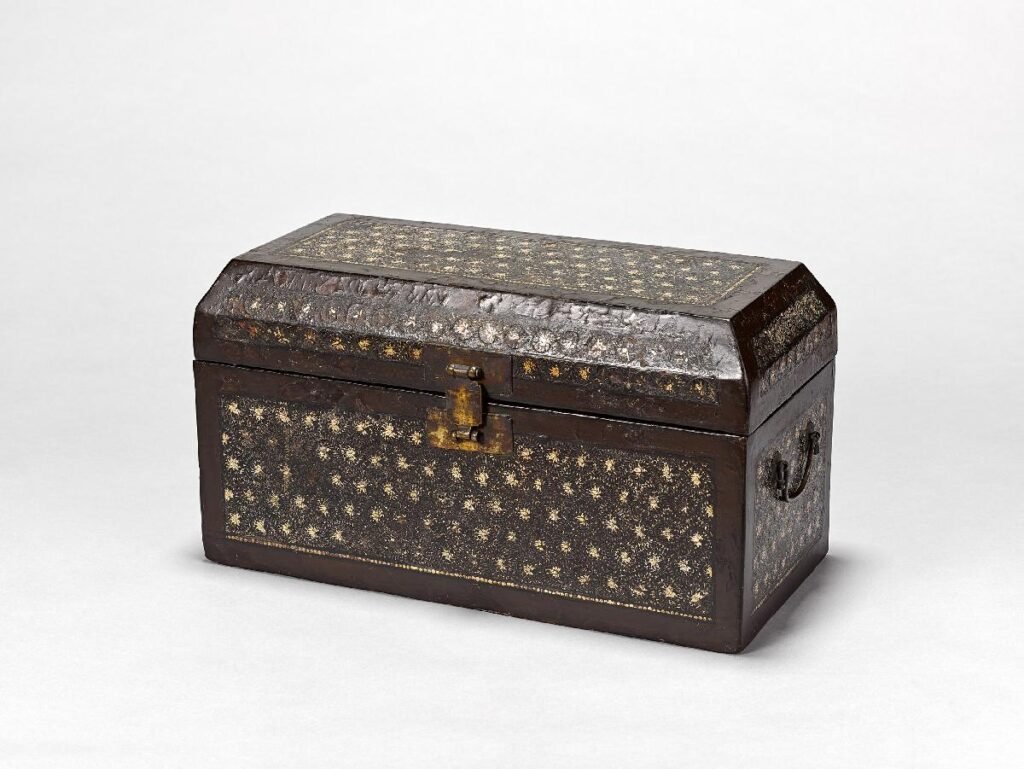
There are six pieces left around the world from the 13th and 14th centuries.
Collection: National Museum of Korea.
2. Najeon Chrysanthemum Vine Pattern Box. Box with inlay mother-of-pearl, chrysanthemum and scroll design. Collection: National Palace Museum of Korea.
This box was returned to Korea from Japan in July 2023. is smaller than the Goryeo mother-of-pearl lacquerware scripture cases and has a detachable lid. Dimension: H. 19,4cm, W. 33cm, D. 18,5cm.
It is decorated with mother-of-pearl inlaid with delicately crafted abalone or conch shells, and is a lacquered work. It was made using the typical Goryeo mother-of-pearl lacquerware production method, the wood-heart-painted skin method.
It was mainly produced as scripture boxes, boxes, and round or flower-shaped boxes for storing Buddhist scriptures, of which scripture boxes were the most numerous.
The entire box is decorated with a chrysanthemum vine pattern using mother-of-pearl and metal wire, and the upper edge of the lid is decorated with a peony vine pattern. The borders of each side are also decorated with small bead patterns. The details are expressed in detail with intaglio lines on small pieces of mother-of-pearl and the vine pattern is created using metal wire, which are characteristics of Goryeo mother-of-pearl decoration.
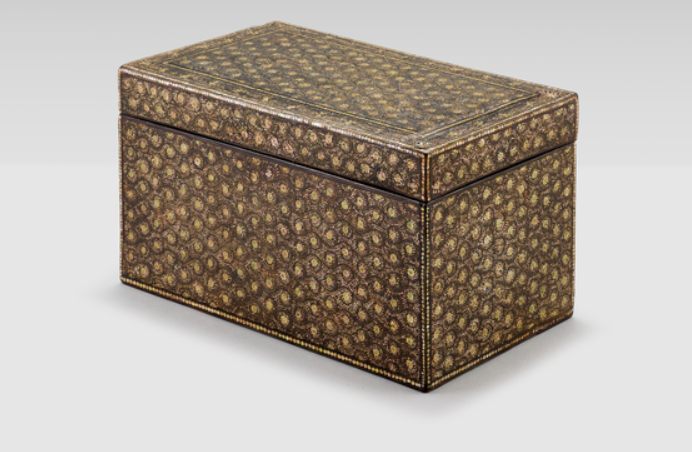
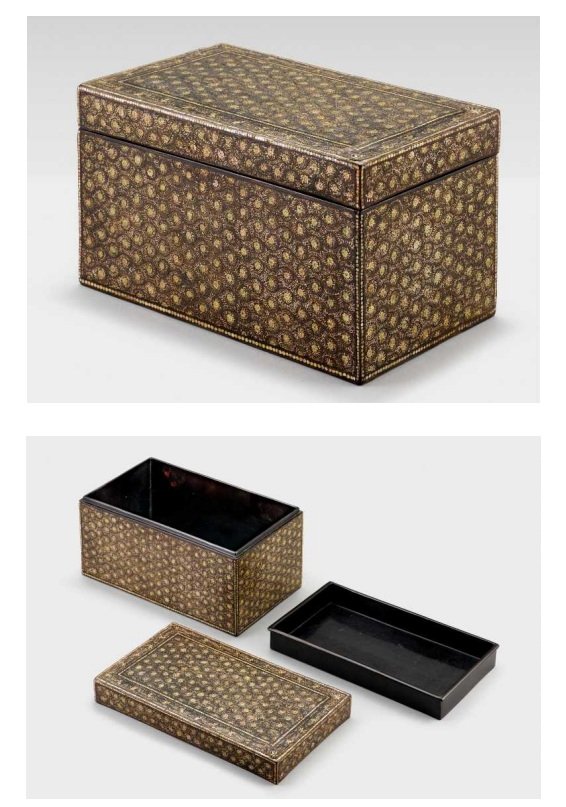
3. Sutra Box with Chrysanthemums and Vines (13th century, Japan’s Tokyo National Museum).
The sides of the lid and the box have the same composition, although the sides of the box also feature a pattern of floral diamonds arranged diagonally at the bottom. The leaves, petals, and central parts of the chrysanthemums and peonies are mother-of-pearl, while the stems are metal wires. The artist succeeded in creating a detailed, rhythmical pattern by rendering each petal and flower with a separate piece of mother-of-pearl.
The main characteristics of this artifact are extremely fine, detailed, and naturalistic motifs, the use of gold, silver, and delicate layering, and a strong appeal to Buddhist and aristocratic luxury.
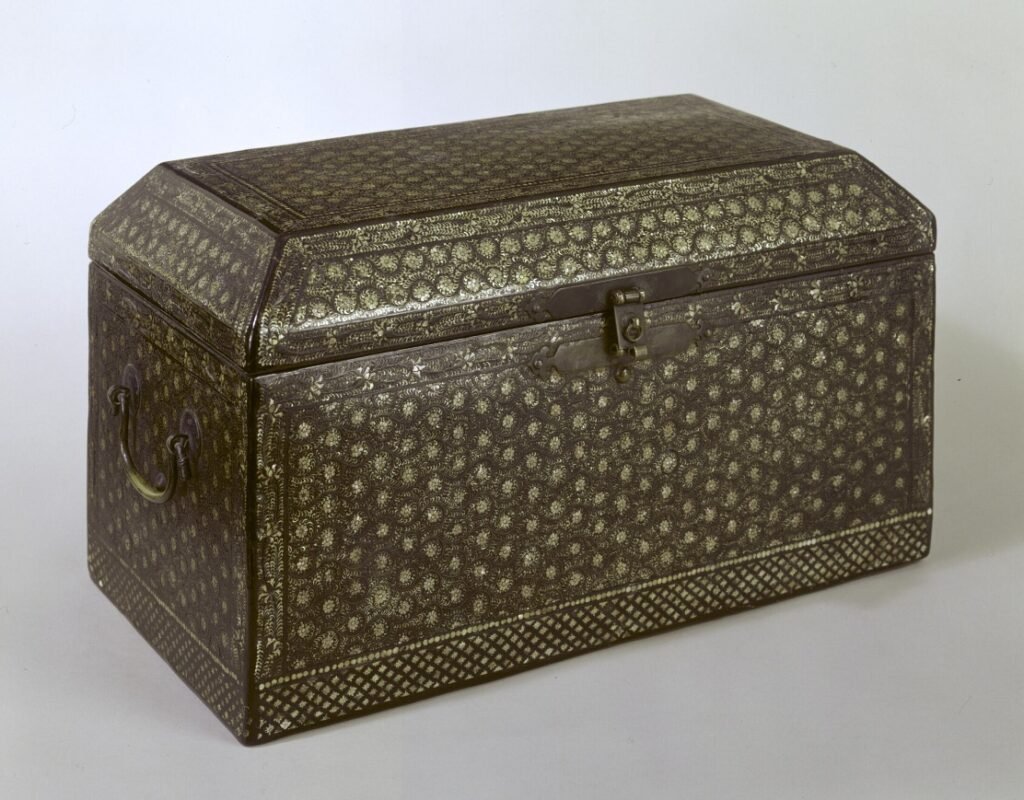
Goryeo dynasty, 13th century
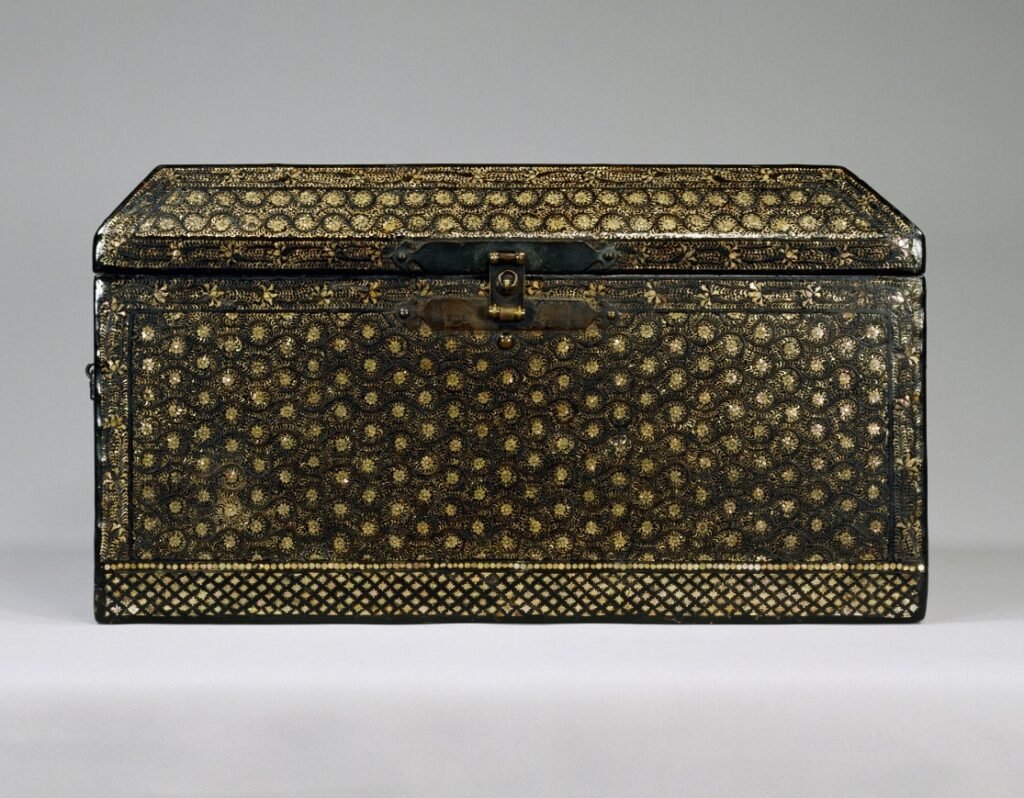
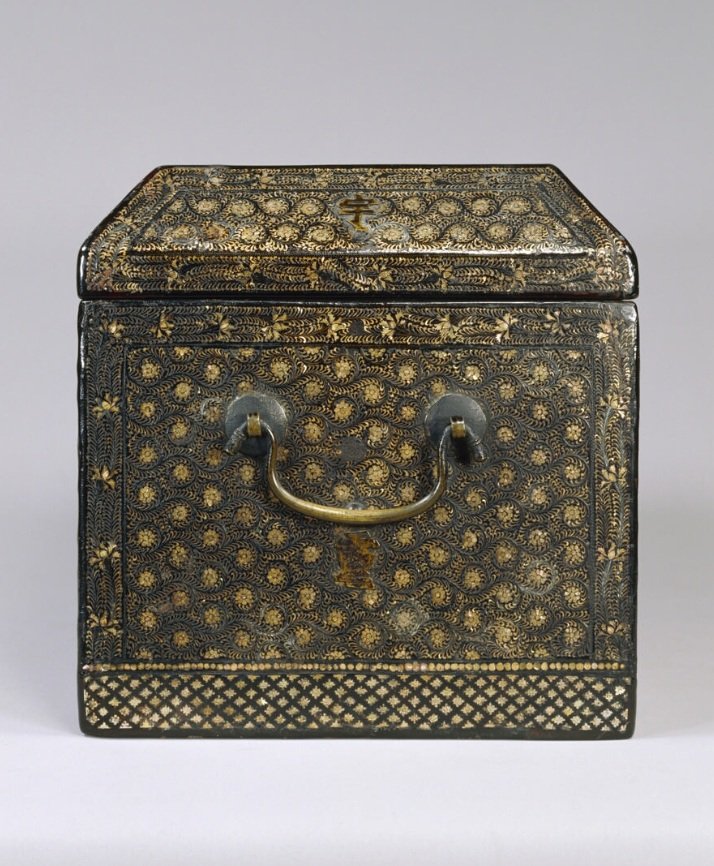
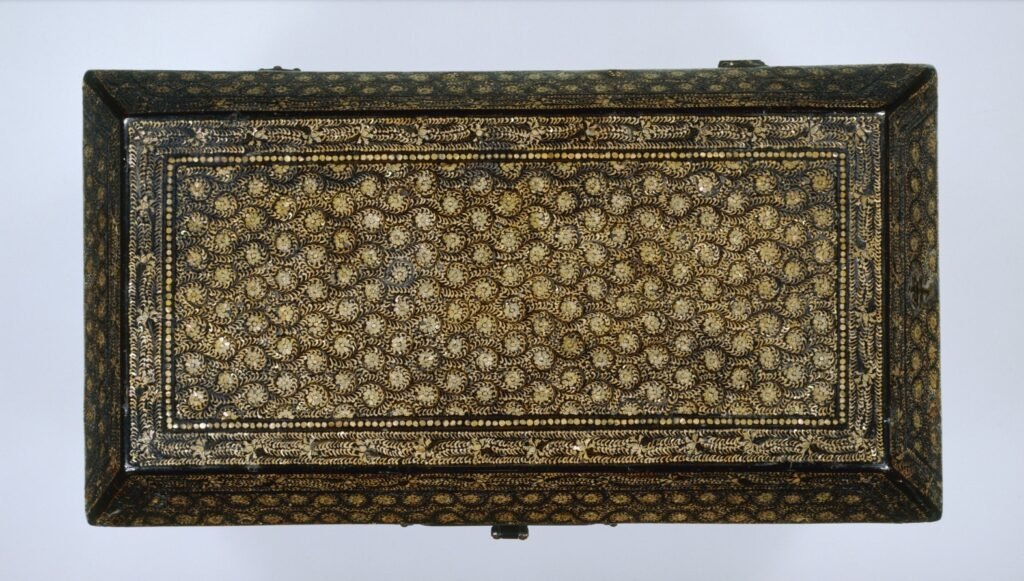
4. Sutra box with chrysanthemum pattern in mother-of-pearl inlay. 13th century. Tokyo National Museum, Japan.
This shell-inlaid box was used to store sutra scrolls and once belonged to the prestigious “Mōri” family. The hinge, lock, and side rings are believed to have been added later in Japan. The character 黄二 (“Yellow-Two”) on one side shows it was originally part of a set. “Yellow” refers to the fourth character in the Senjimon (Thousand Character Classic), an ancient text used for learning Chinese characters.
At the center of the lid, the title of the Flower Garland Sutra (Buddha-avatamsaka-nama-mahavaipulya-sutra) is delicately inlaid, surrounded by a diamond-shaped chrysanthemum motif, with leaves and branches extending from each side. The box’s sides are bordered with crossed-diagonal and circular patterns, filled with standing chrysanthemums arranged in diagonal lines.
The inlay work is exceptionally fine, made from very thin, tiny pieces of shell. The chrysanthemum design is subtle and refined, not flashy. Its floral shapes closely resemble those found on Goryeo celadon ware from the same period.
Despite a trace of fire damage, this box survives as a rare example of Goryeo craftsmanship—elegant, intricate, and quietly powerful, a testament to its journey through turbulent times.
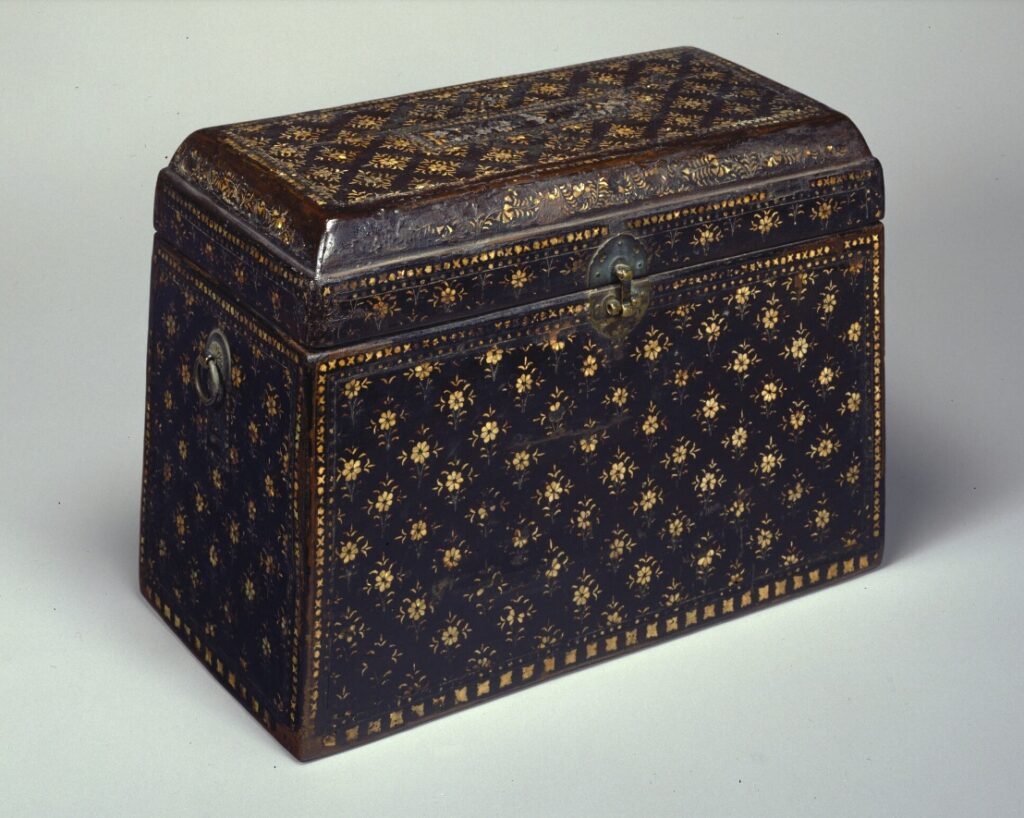
H. 26cm, W. 37,8cm, D. 19,2cm.
Goryeo period – 13th century
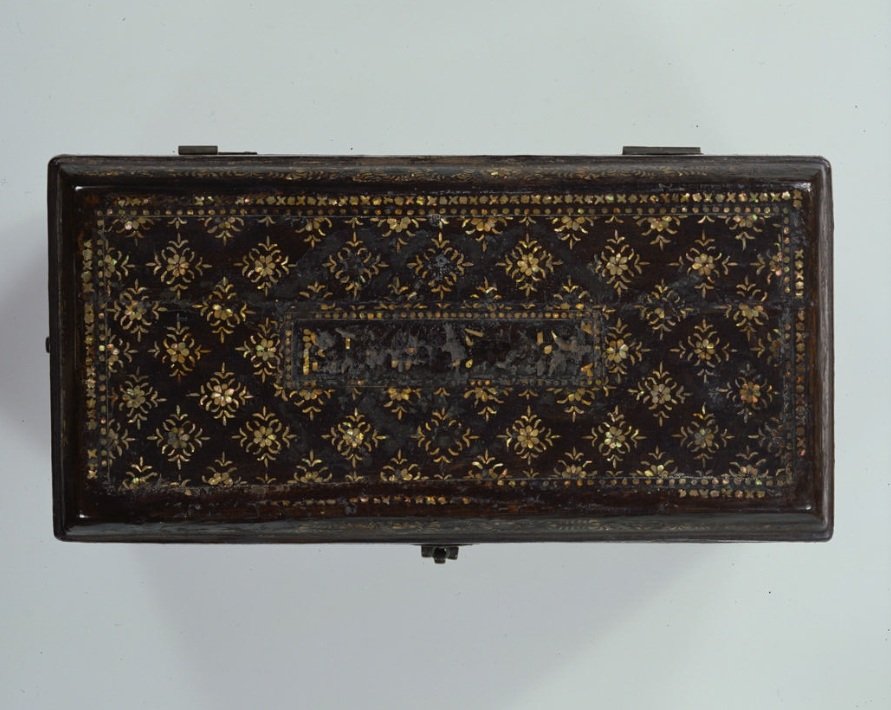
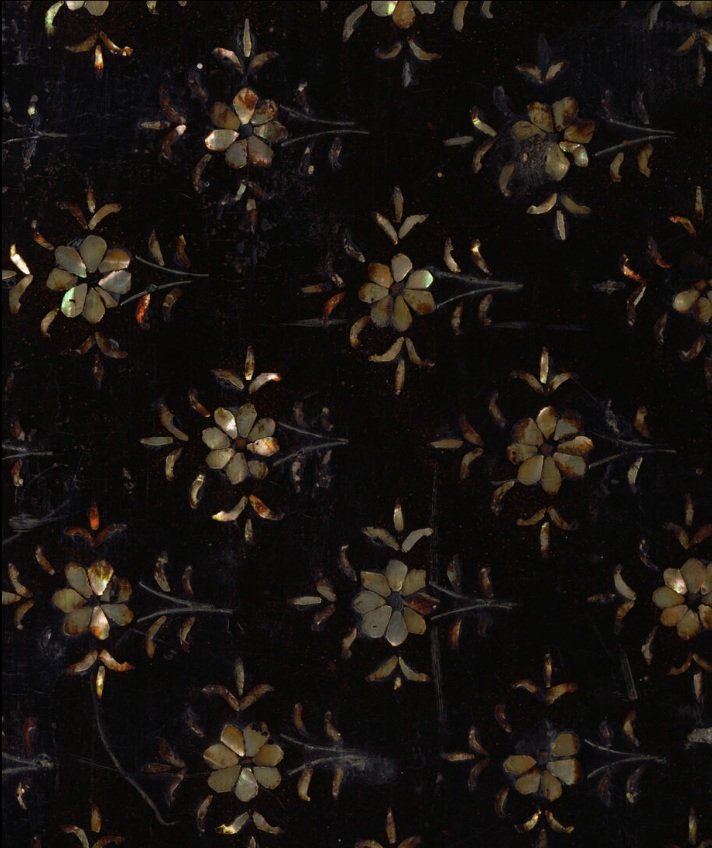
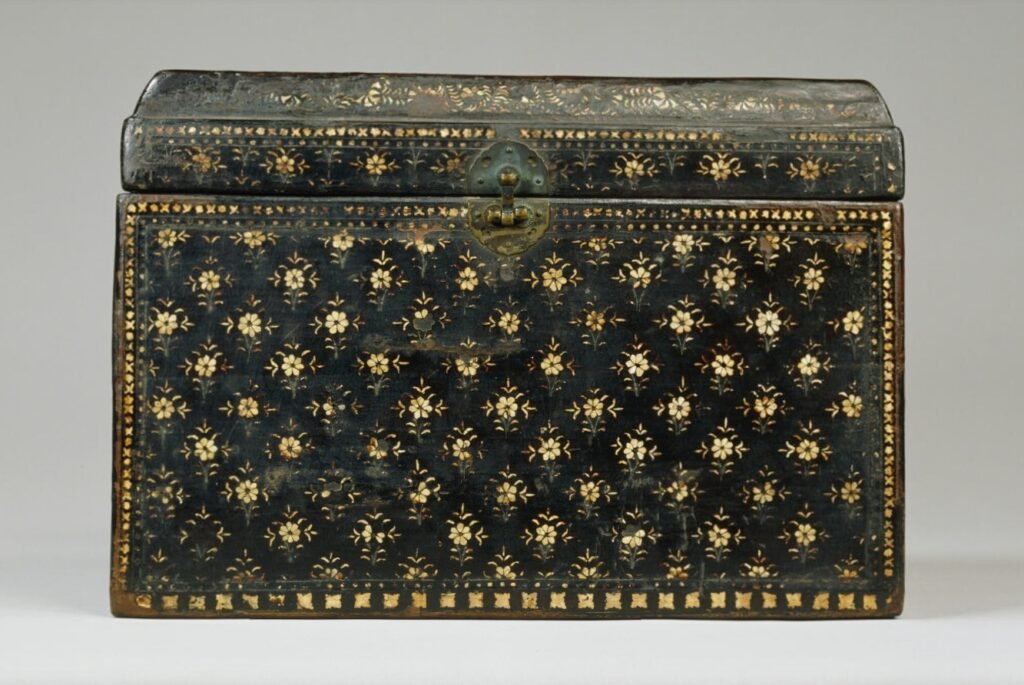
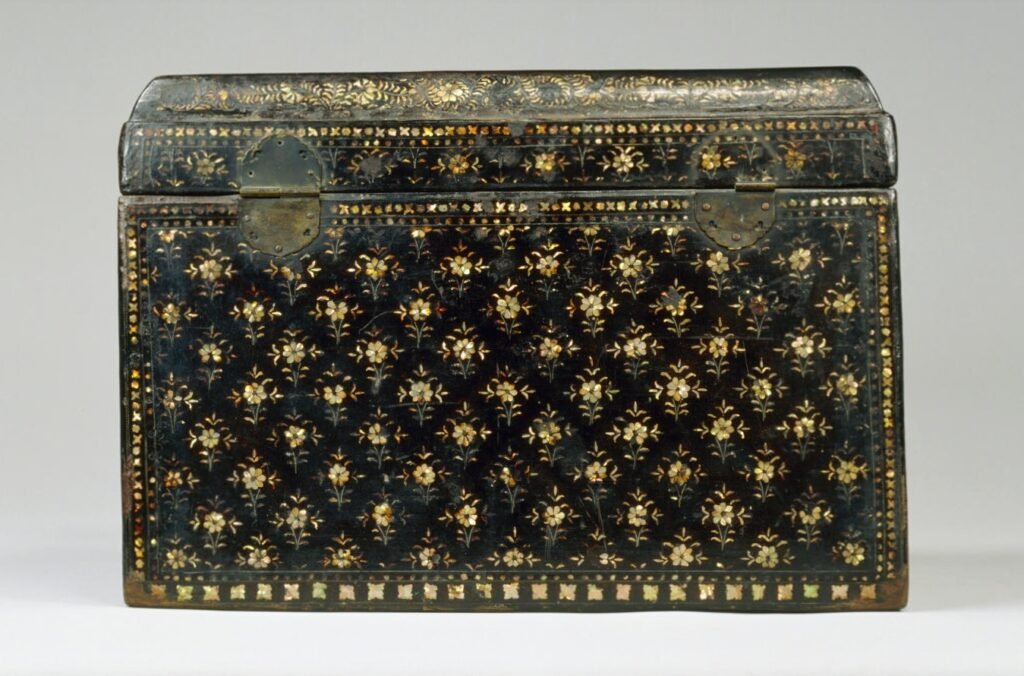
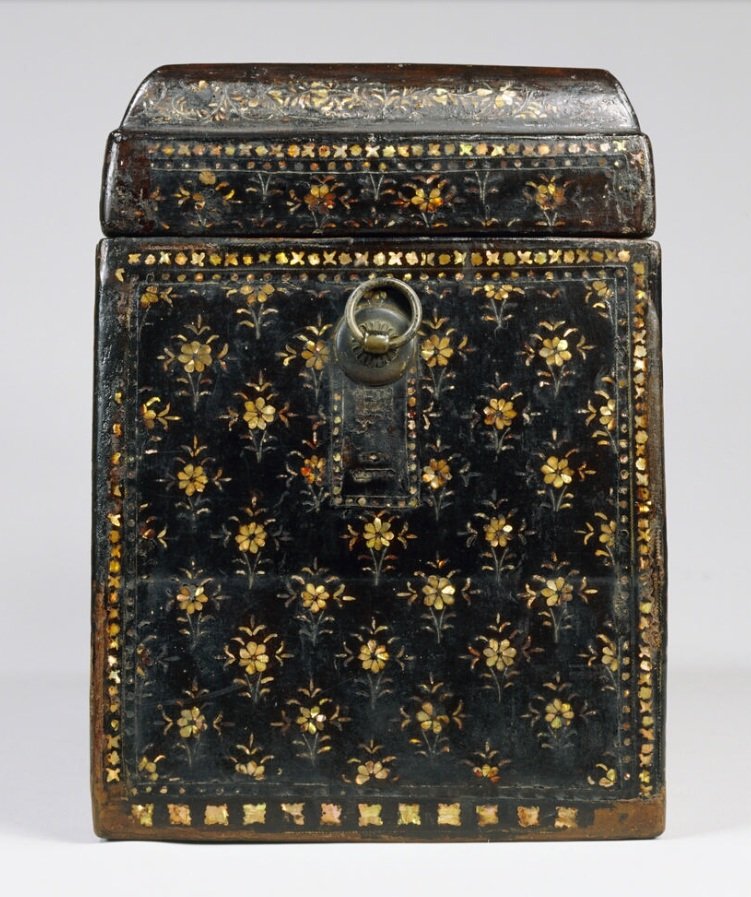
5. Trefoil-shaped covered box with decoration of chrysanthemums (12th century, The MET. Metropolitan Museum of Art. New York, USA.) 나전 대모 칠 국화 넝쿨 무늬 꽃 모양 합 고려
螺鈿玳瑁漆菊唐草文半花形盒 高麗
Lacquer, celadon, or bronze ensembles composed of four trefoil boxes surrounding a larger round or flower-shaped box served as containers for cosmetics or incense. Very few Goryeo-period lacquer boxes with mother-of-pearl inlay have survived; this is a particularly fine example.
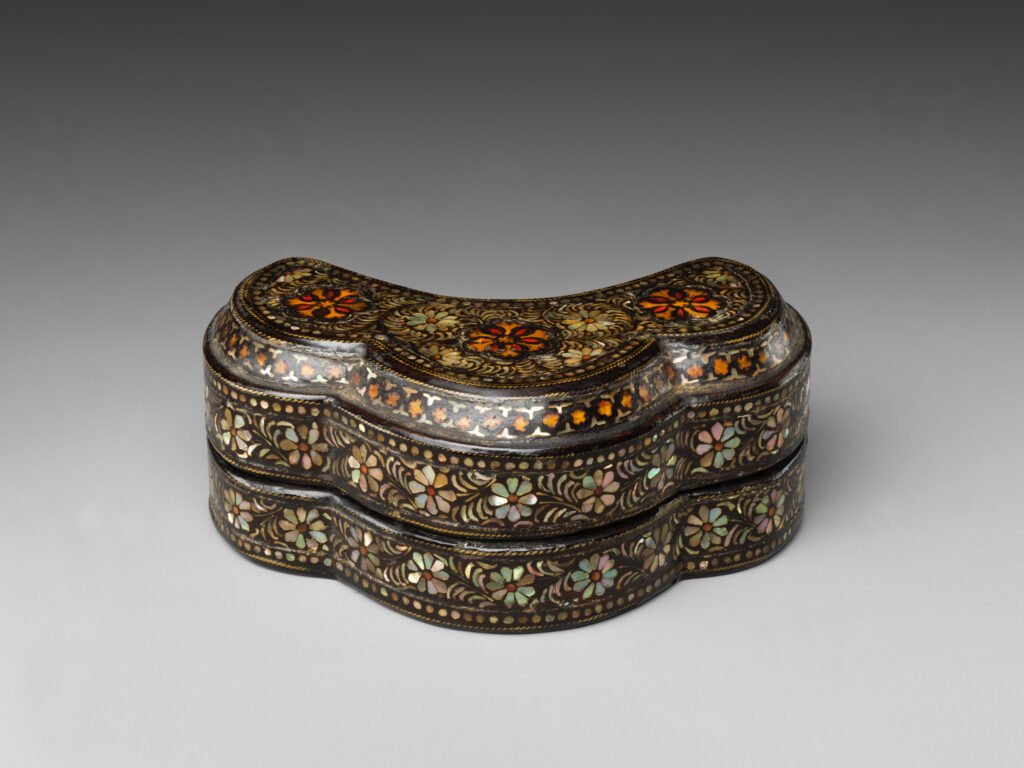
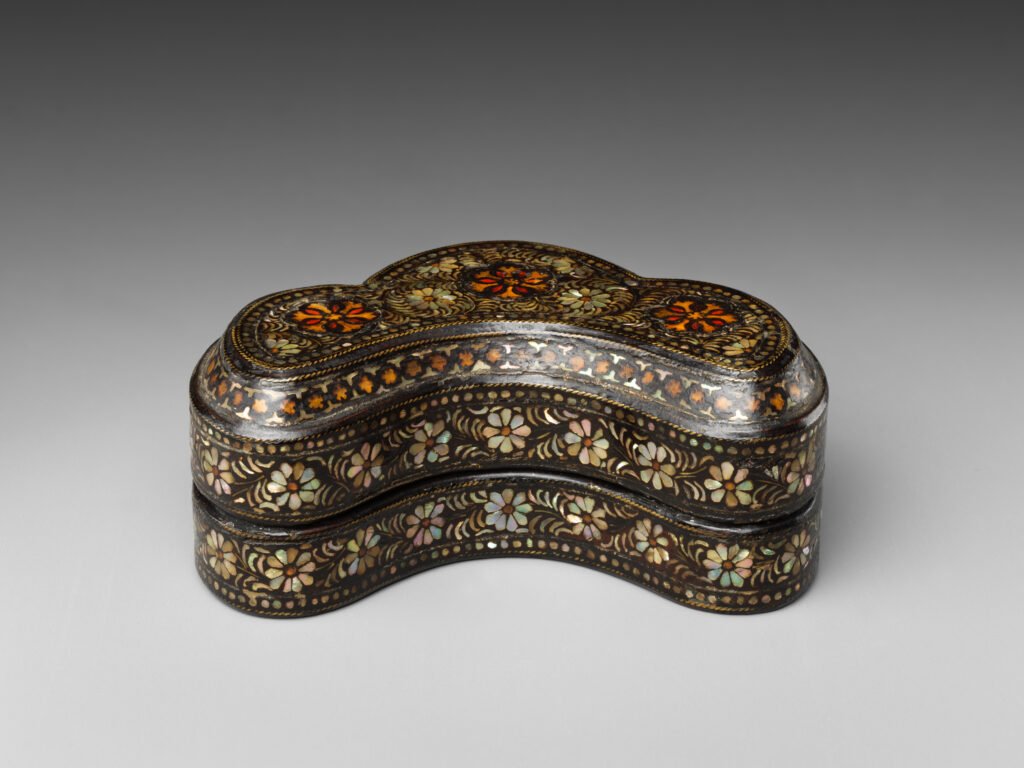

H. 1 5/8 in. (4,1 cm); L. 4 in. (10,2 cm); D. 1 3/4 in. (4,4 cm).
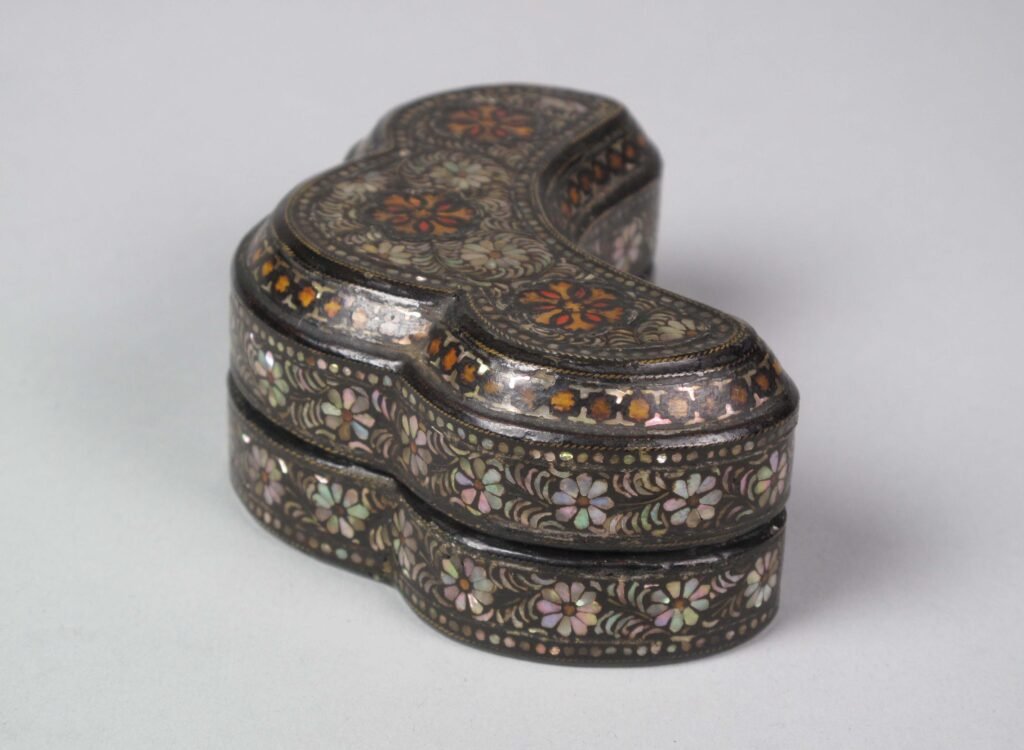
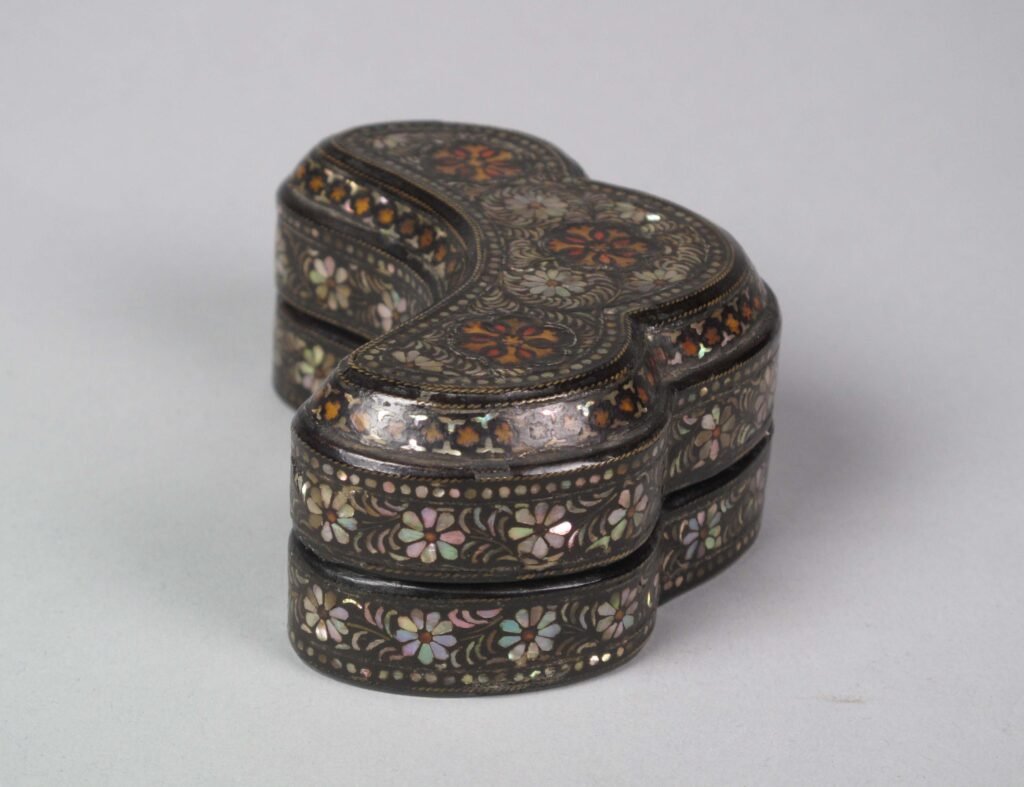
6. A lacquered covered box with decoration of chrysanthemums. Made of wood and inlaid with mother-of-pearl and tortoise shell. Goryeo Dynasty, 12th century CE, now housed at the Taima-dera Temple in Japan.
This artifact features refined patterns that well reflect a kind of national dignity and it displays a superior technical dexterity. Here again the lines of twisted brass wire divide the decorations.
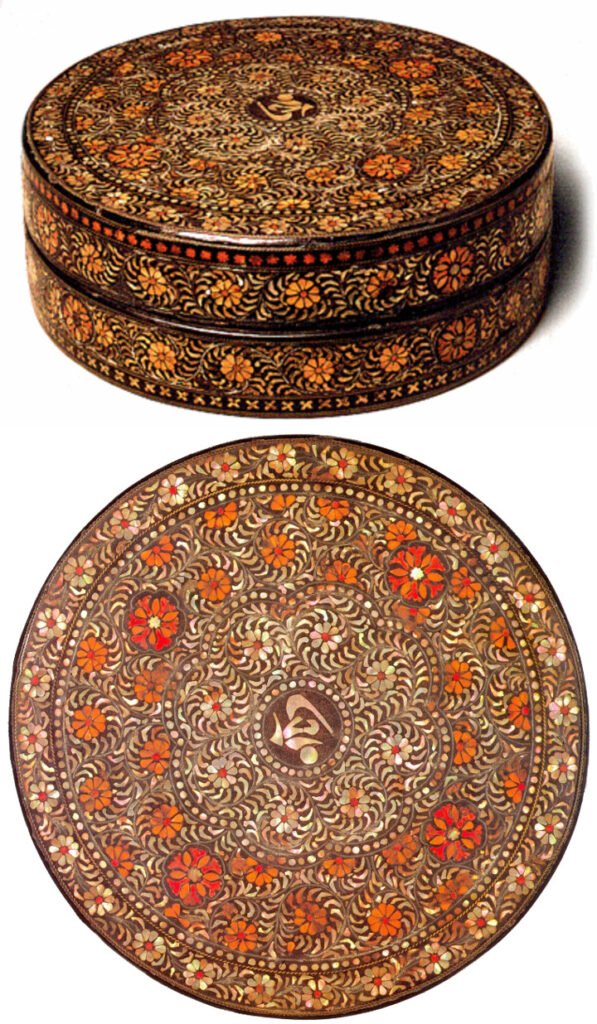
H: 4,5 cm, Diameter: 12,4 cm
7. Covered Box, Arabesque design in mother-of-pearl inlay. Lacquered wood. Goryeo dynasty, 14th century. Collection Tokyo National Museum.
A small box inlaid with mother-of-pearl, featuring a rhythmic design of flowers and grasses. On the front of the lid, a densely leafy vine extends outward, forming a small circle that ends in a flower with overlapping petals. The flower’s center is star-shaped. A band of sawtooth patterns encircles the edge of the lid, while the sides of the box are decorated with floral and grass motifs similar to those on the lid.

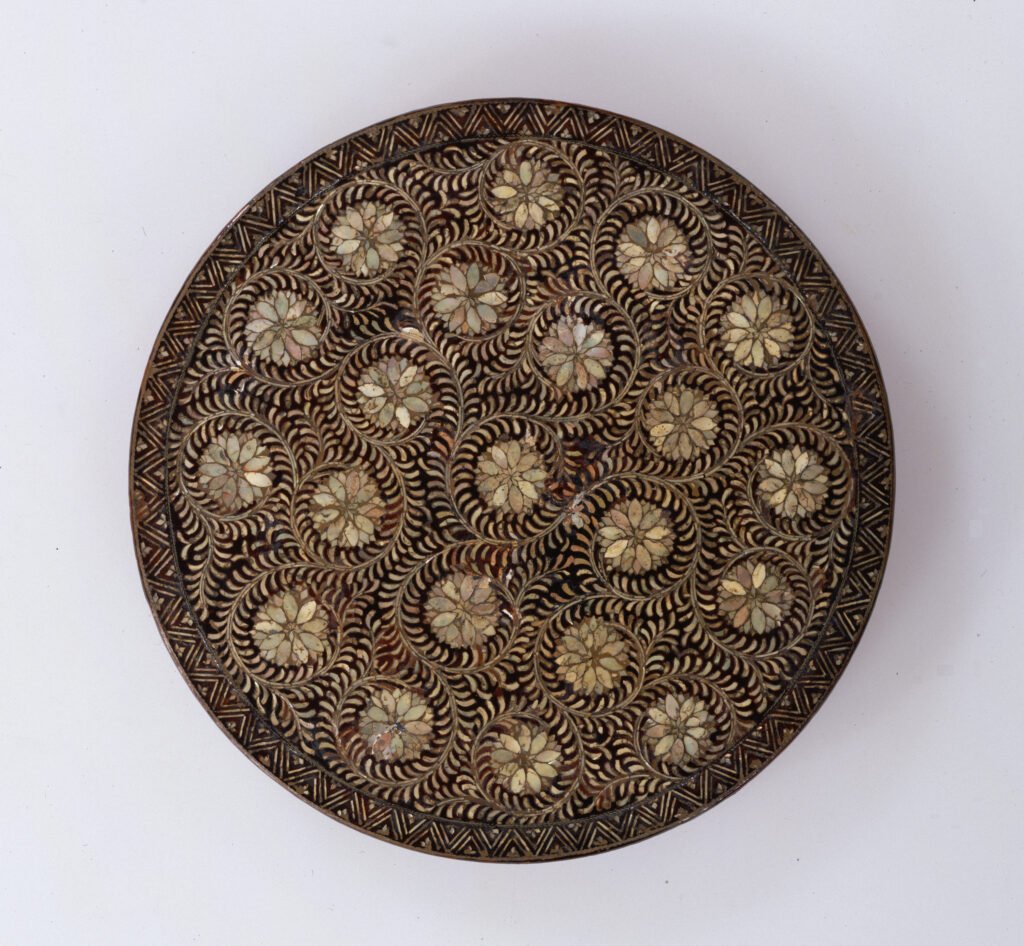
8. Mother-of pearl small box. Chrysanthemum arabesque design. Late Goryeo to early Joseon period.
Small box with rounded shape and intricate floral arabesque patterns. The pattern are created using mother-of-pearl inlay. It was probably used by an aristocratic woman in the Goryeo dynasty to store her cosmetics. H. 11,5cm, W. 17cm, D. 9cm.
Collection: The Museum Yamato Bunkakan. Japan.
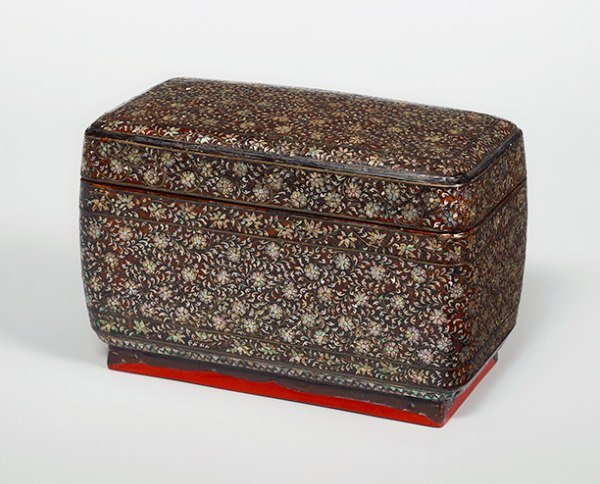
Joseon Dynasty (1392–1897)
Joseon “najeonchilgi” was more austere and reflected Confucian simplicity, commonly used in furniture, storage chests, and daily-use items.
1 Ogival tray decorated with floral scroll. Joseon dynasty. 15th – 16th century. Collection: The MET, Metropolitan Museum, New York, USA.
Floral scrolls consisting of delicate leaves and chrysanthemum-like petals are ubiquitous in Korean lacquers dating to the Goryeo dynasty, an aristocratic age noted for its elegant artistic traditions. The scrolls on this tray follow that tradition but are distinguished from those on earlier pieces by the use of pearl shell, rather than silver or brass wire, for depicting the stems. This tray, which is comparable to one in the Tokyo National Museum, is among the few Korean examples that can be dated to the beginning of the subsequent Joseon dynasty.
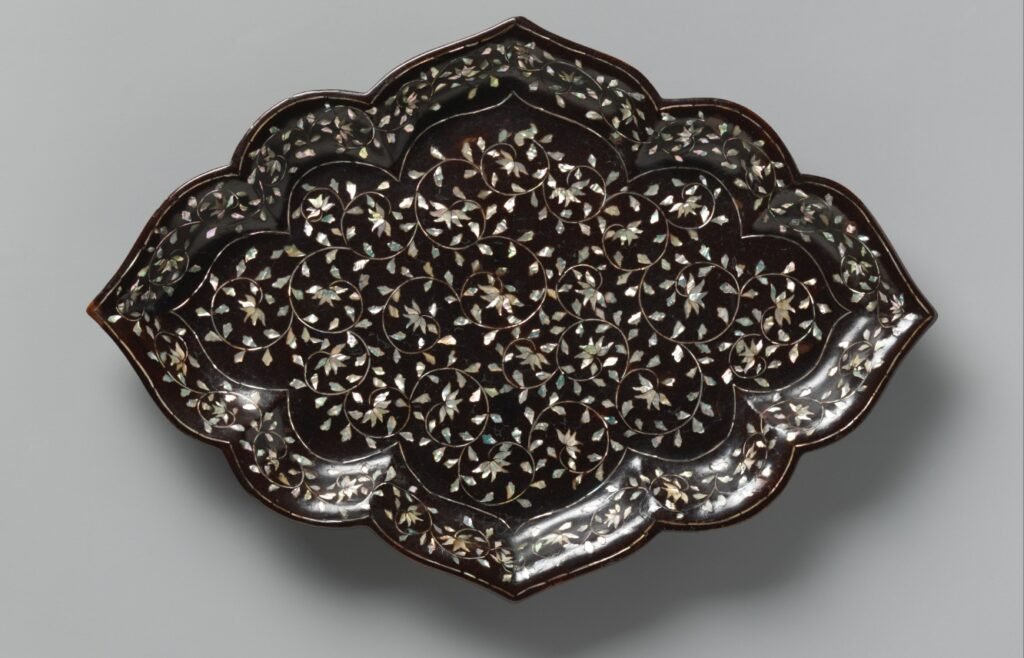
H. 1 5/8 in. (4.1 cm); W. 12 in. (30.5 cm); L. 17 3/8 in. (44.1 cm)
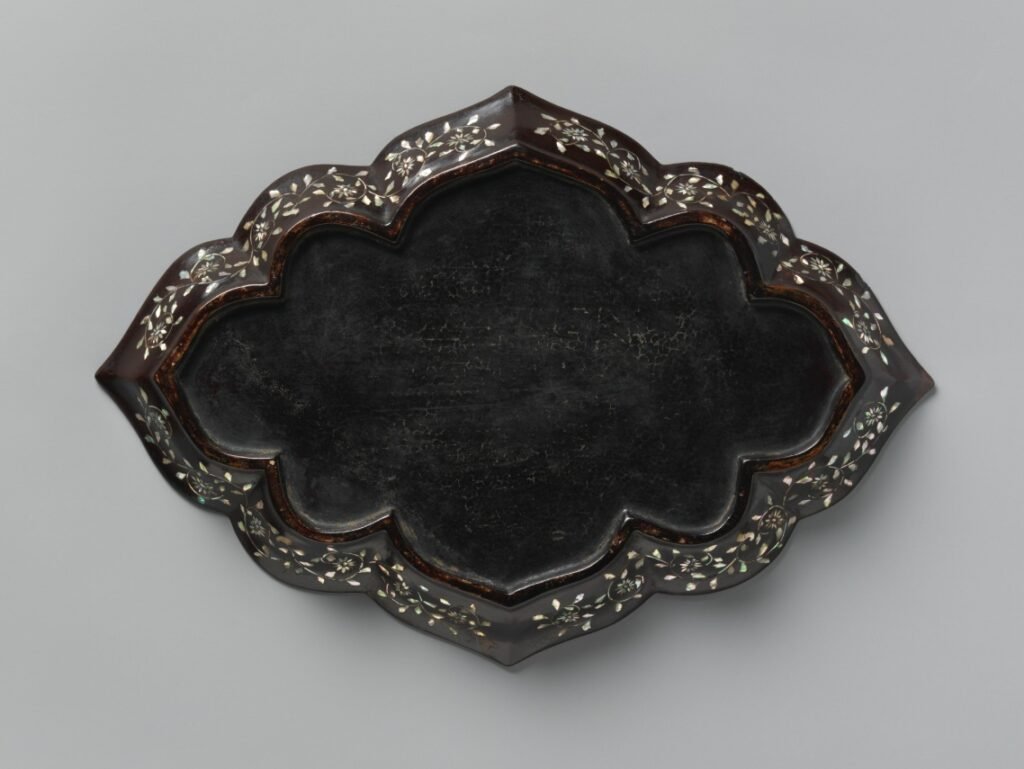
2. Box with tree peony arabesque pattern in mother-of-pearl inlay. Joseon dynasty. 17th – 18th century. Collection: Tokyo National Museum, Japan.
This shell-inlayed box from the Joseon Dynasty is known to have been owned by the “Ōuchi” clan. It was used to keep garments, as it is shallow and large. The lid fits the body neatly. A peony arabesque pattern in shell-inlay decorates the entire box. The characteristic of that pattern is the contrast between the flowers and buds expressed boldly with large pieces of shell and the thread-thin vines connecting them. There are several other boxes known to have this type of peony arabesque, but this piece is considered to be particularly excellent, displaying refined taste.

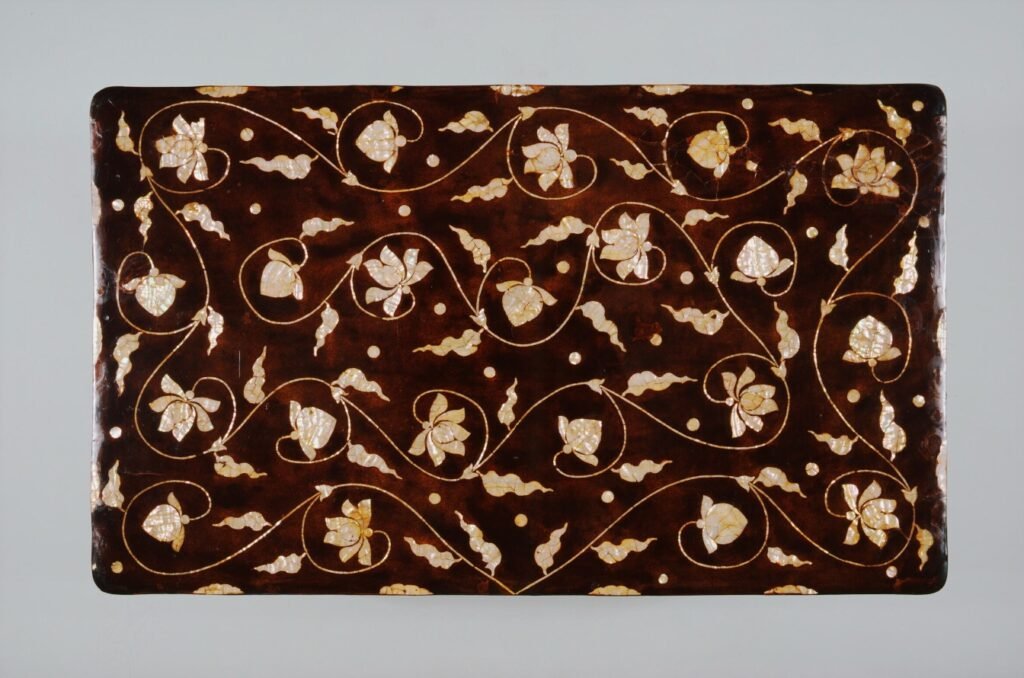
3. Box with lotus motifs. Joseon dynasty – 1500-1650. Asian Art Museum – San Francisco, USA.
The stylistic elements and materials used on this box are reminiscent of the Goryeo dynasty mother-of-pearl lacquer tradition. Twisted brass wires are applied to depict the peony branches and tortoiseshell for the circular patterns. However, while Goryeo artists would have filled the whole surface with small repetitive patterns, Joseon artists, especially those active during the seventeenth century, designed the main motifs to be bolder and more prominent. On this box, the peonies are executed with larger and less detailed pieces of mother-of-pearl, arranged in structured and repetitive patterns, which highlight the distinct hues and textures of the material.
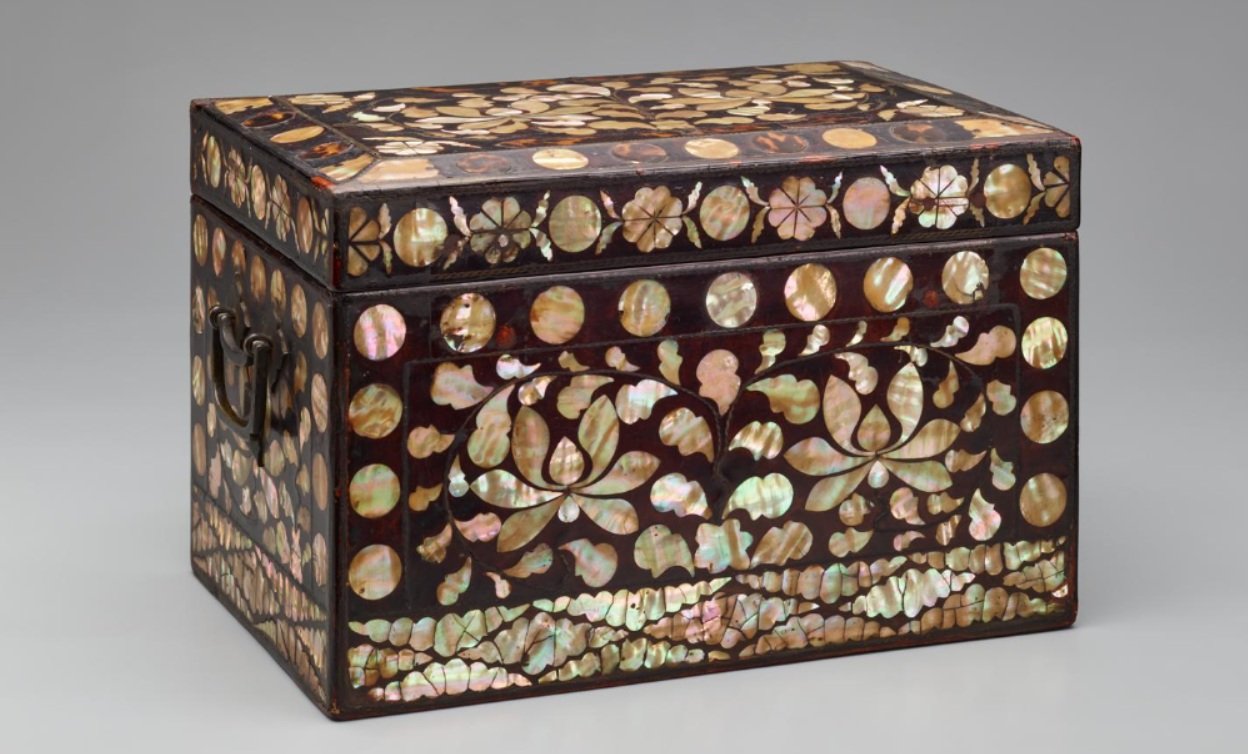
H. 20,6cm, W. 33.cm, D. 21,6cm.
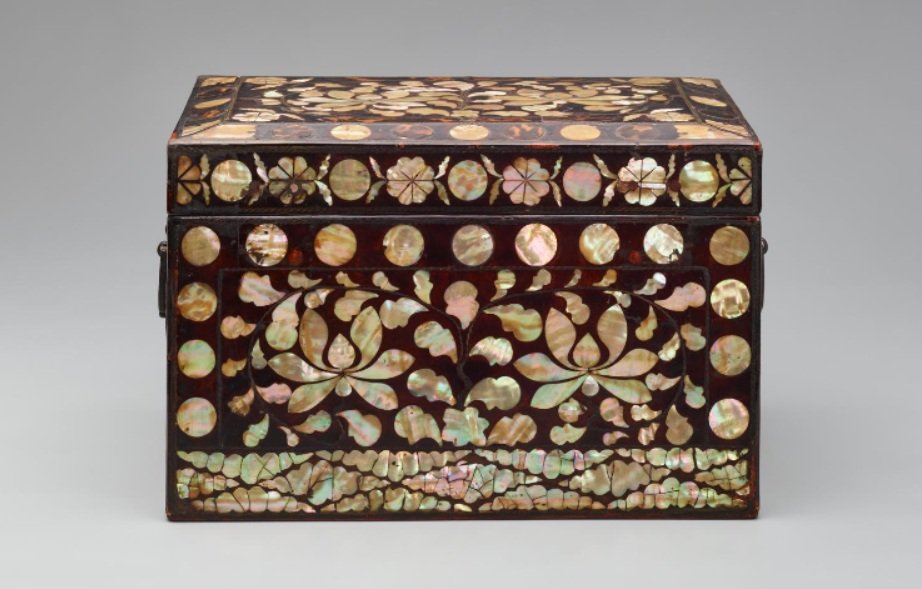
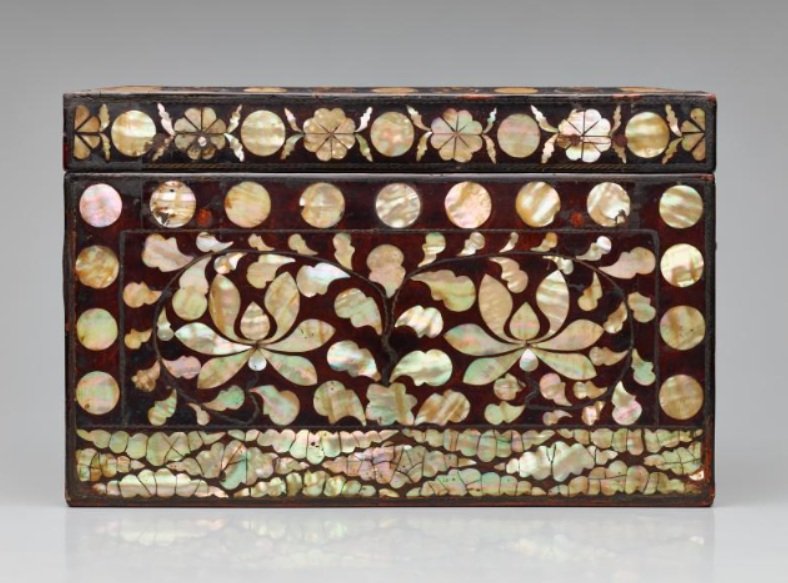
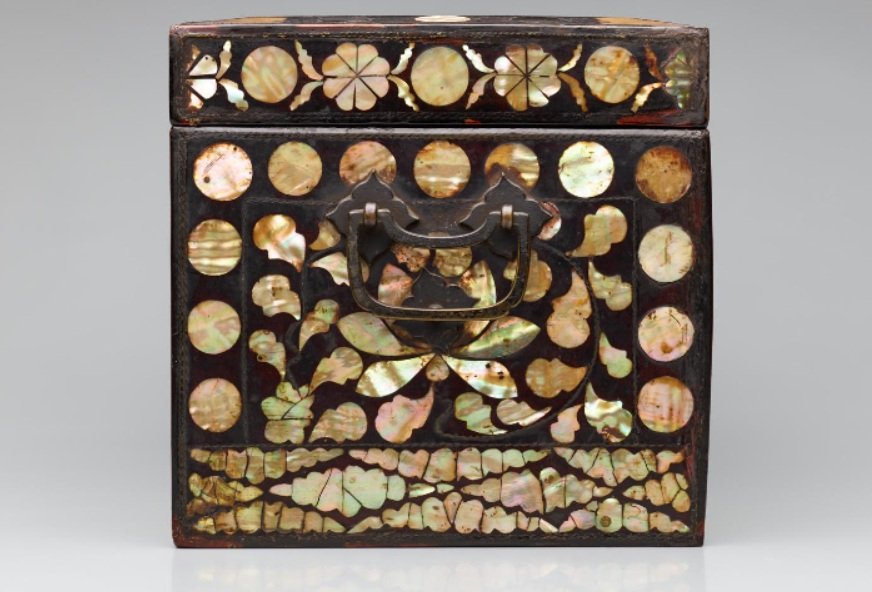
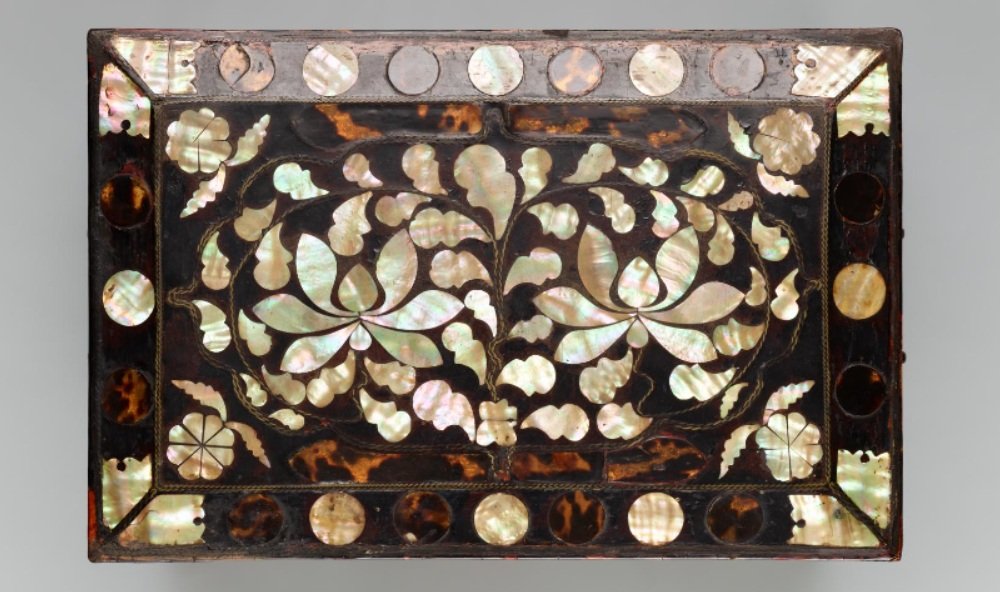
4. Box with grapevine motif. Joseon dynasty. 1700-1800. Asian Art Museum, San Francisco, USA.
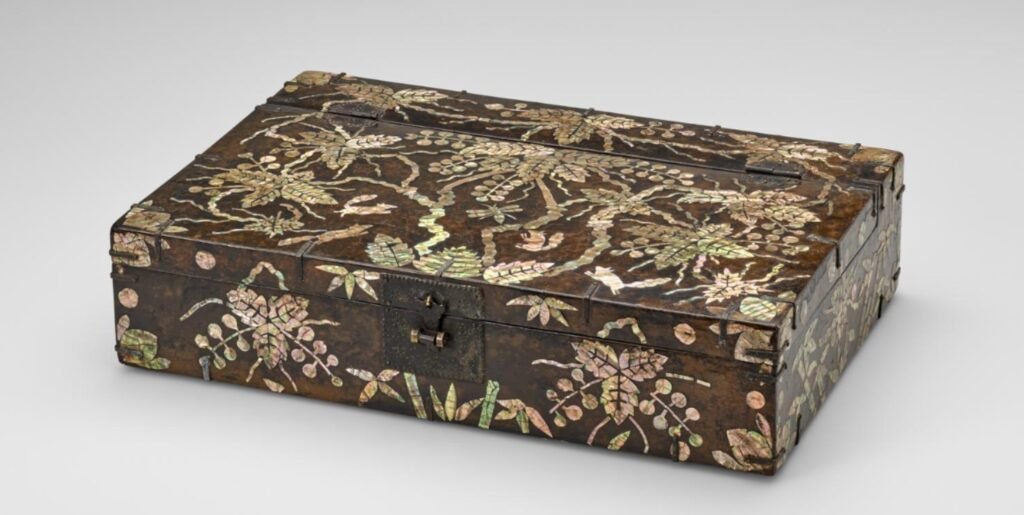
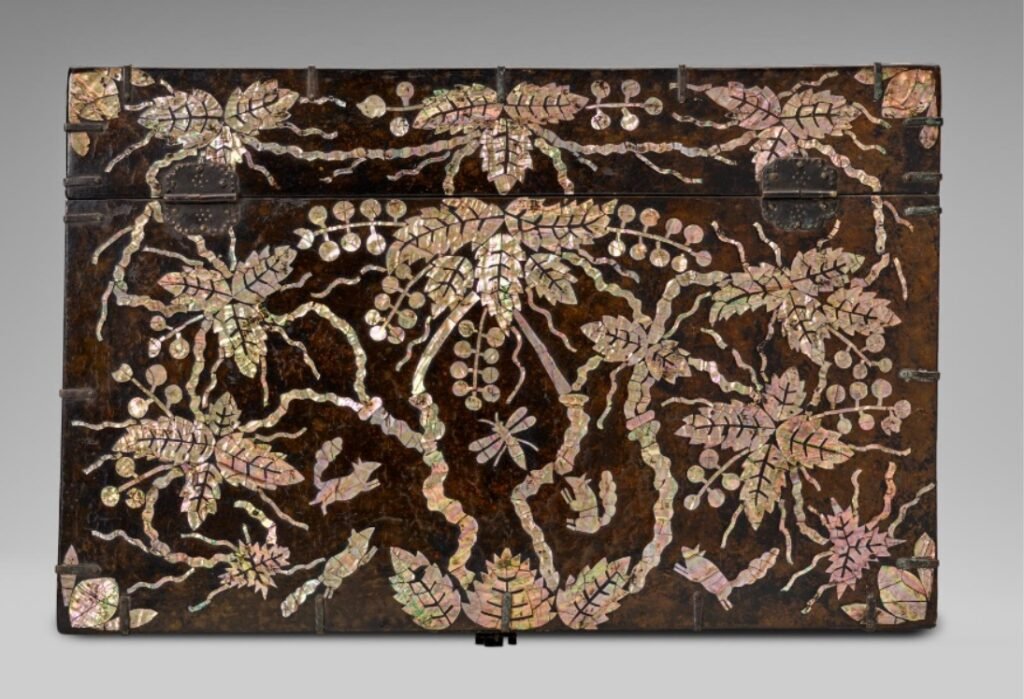
5. Mother-of-pearl, plum, bamboo, and bird pattern box. Joseon- 17th 18th century. Horim Museum, Seoul, Korea.
It is a box that opens by lifting the square lid upward. Two noodle-shaped grab bars are attached to the area where each side meets to enhance sturdiness. The upper surface is decorated with a pictorial flower-and-bird pattern consisting of plum blossoms, bamboo, birds, and butterflies using pleating and slapping techniques without any separate compartments. The side surface is decorated with a flower-and-bird pattern of plum blossoms and bamboo, and two pine trees and a
Several cranes sitting on top are arranged symmetrically using the pleating and slapping techniques. It shows a change from the regular arrangement of the patterns of the early Joseon period. Judging from the composition of the screen, the technique of mother-of-pearl, the use of the saddle, and the condition of the black lacquer with a dark red color, it is a Joseon pattern that is slightly earlier than the flower-and-bird pattern and the four gentlemen pattern that were popular in the 18th and 19th centuries.
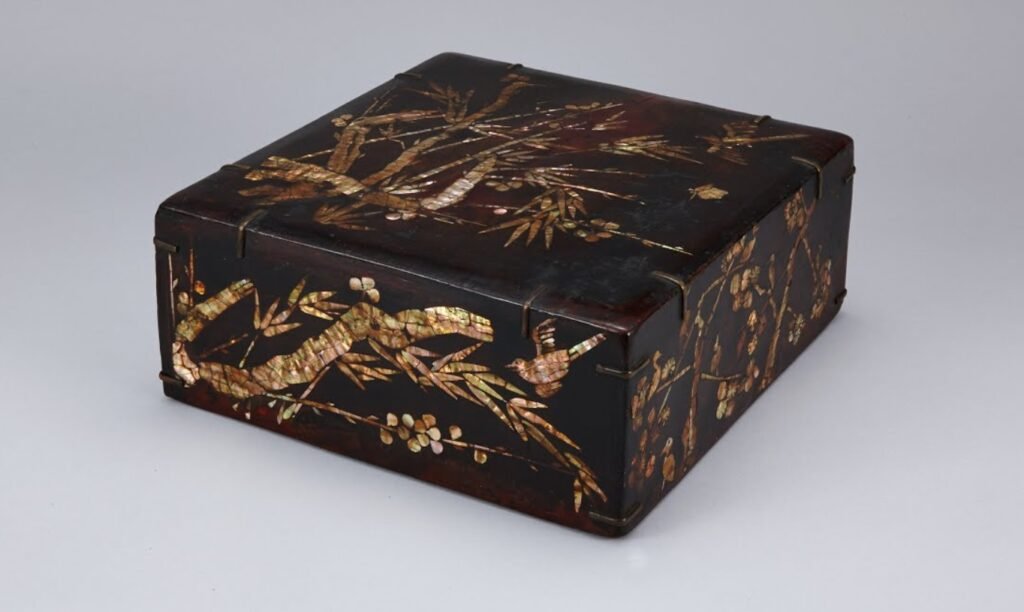
6. Mother-of-pearl, plum, bamboo, bird pattern box. Joseon 18th century. Horim Museum, Seoul, Korea.
It is a square box with a lid that can be opened by lifting it upward. Pine was mainly used.
The body is joined with a cross-mesh structure and flower -shaped trapezoids are attached to each corner
There is an inner box inside. The four corners of the lid are treated with gentle diagonals. The sides of the lid are decorated with bamboo, plum blossoms, chrysanthemums, and grass flowers, and the top is delicately depicted with a pair of birds playing with a background of plum blossoms and bamboo.
This pattern composition reflects the characteristics of mother-of-pearl lacquerware that was popular at this time
On the other hand, the appropriate use of the percussion method, which breaks the mother-of-pearl with a hammer to induce a diffused reflection effect, makes it look even more splendid.
.

7. A mother-of-pearl inlaid lacquer table, Joseon dynasty 17th – 18th century. Auction in the US & Korea. (2025)
The hexafoil table set on six cabriole legs, finely decorated in inlaid mother-of-pearl with geometric patterns and floral scrolls of chrysanthemum on black lacquer ground, applied with red lacquer on the interior
16 3⁄4 x 10 3⁄8 x 8 1⁄8 in. (42.5 x 26.4 x 20.6 cm.)
This piece is estimated to be a mother-of-pearl lacquerware from the early 16th century Joseon Dynasty, and among the surviving Joseon-era small tables, it exemplifies a high level of design and decoration. The overall shape is nearly hexagonal, with graceful curves. The tabletop, legs, and even the connecting sections are lavishly decorated using the mother-of-pearl technique. The tabletop is meticulously inlaid with mother-of-pearl. The central design features a scalloped arabesque, surrounded by a cloisonné pattern of smaller arabesques and triangular mother-of-pearl. This pattern composition is characteristic of early Joseon lacquerware. It strives for realism, moving beyond stylized patterns, and allows the white space of the background to stand out. Of particular note is the openwork decoration on the upper portions of the six legs. The openwork is elaborately woven into the wide bands connecting the tabletop and legs. This structure, rarely seen in typical mother-of-pearl lacquer tables, maximizes the decorative beauty. The legs are curved like animal feet, tapering towards the bottom, adding stability and sophistication to the overall look.
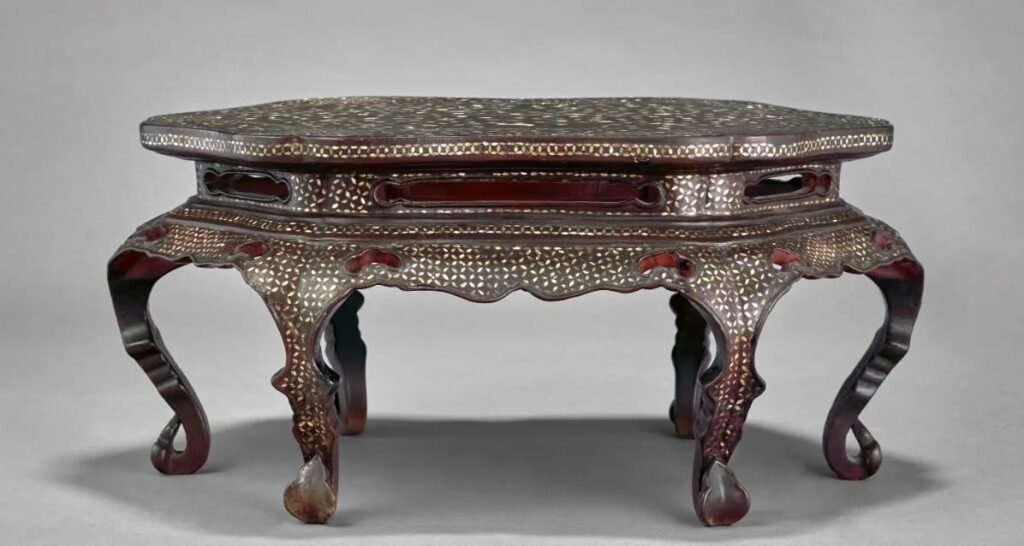
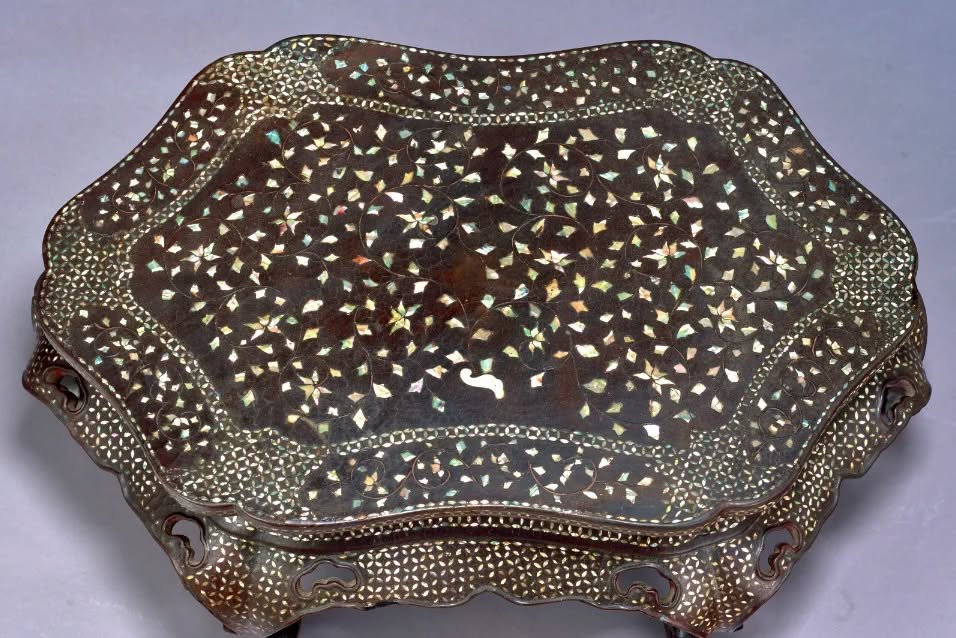
8. A mother-of pearl inlaid foliate shaped tray. Joseon dynasty. (16th century). Auction in the US & Korea. (2025)
Inlaid on the interior and exterior in mother-of-pearl with lotus arabesques and circular geometric pattern on a black ground, the foliate-shaped foot rim enclosing the base of red lacquer
17 3⁄8 in. (44.1 cm.) long.
This work features a unique form modeled after a “neunghwachang” (flower window), and its overall balanced composition and intricate craftsmanship stand out. The center is densely decorated with arabesque patterns, while the rim features slightly larger pieces arranged in a rhythmic grid pattern. This design goes beyond mere practicality, embodying a pursuit of decorativeness and aesthetic perfection. One of the new characteristics of early Joseon lacquerware is the use of small floral patterns and metal lines, similar to those of the Goryeo Dynasty, but with a focus on utilizing white space to reveal the underlying lacquer. This type of mother-of-pearl lacquerware was primarily used by the royal family and the upper class, and its production required considerable time and skilled craftsmanship. This mother-of-pearl lacquerware is a representative example of the exquisite craftsmanship of the Joseon Dynasty. It is characterized by its ornate petal patterns and delicate border decoration, and the subtle sheen of the mother-of-pearl contrasts with the dark background, creating a striking visual effect.
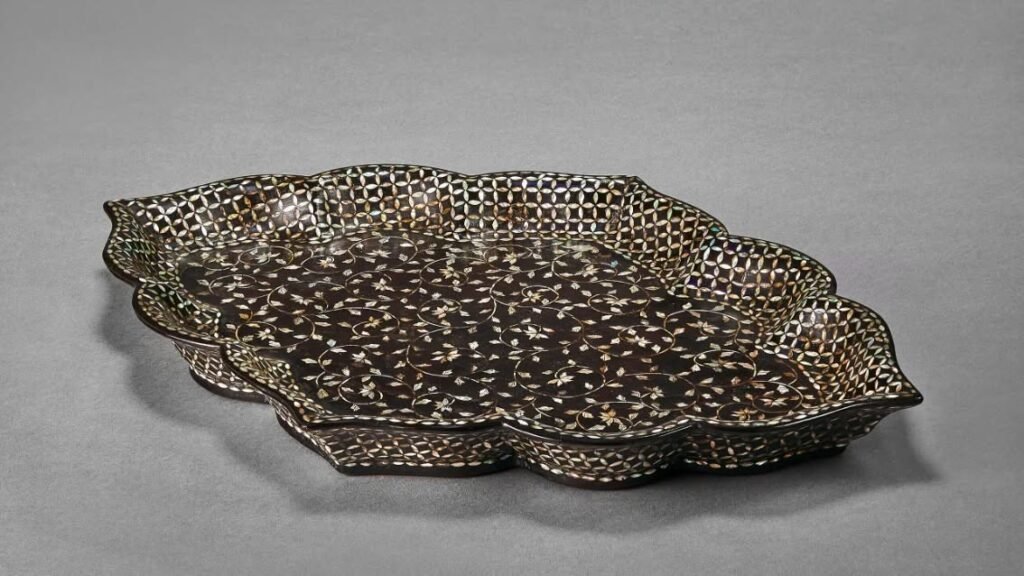
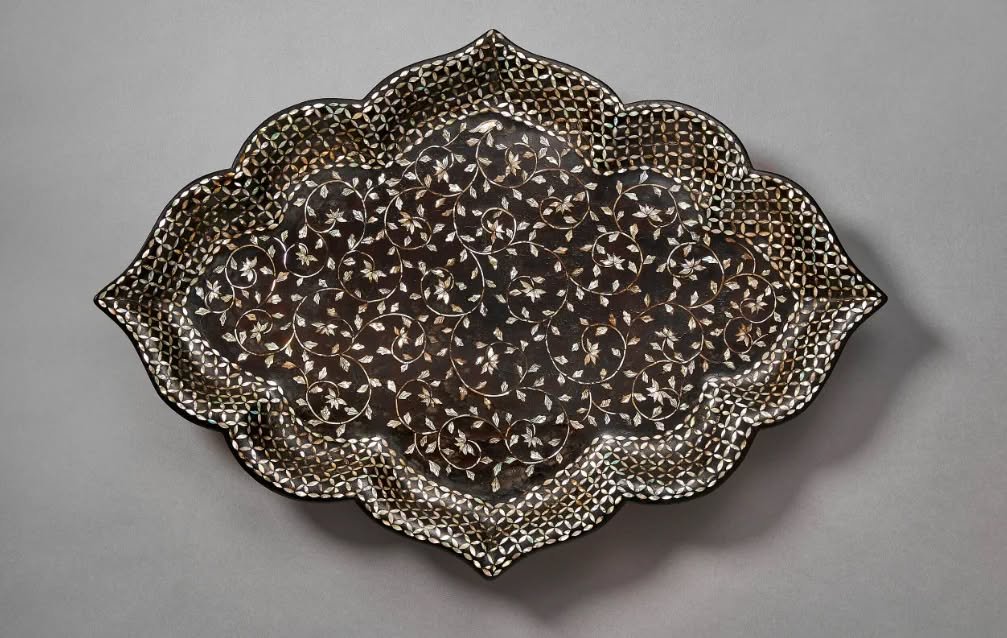
9. Korean red-lacquered mother-of-pearl inlaid chest. Joseon dynasty. Late 19th century to early 20th century. Collection: National Museum of Korea.
This type of furniture was traditionally used to store fine clothing, bedding, and ceremonial textiles. Produced in the late Joseon to early 20th century, it is finished in bright cinnabar-red lacquer (주칠, juchil) and richly inlaid with mother-of-pearl depicting cranes, deer, pine, bamboo, rocks, and pavilions—motifs associated with longevity, virtue, and auspicious fortune.

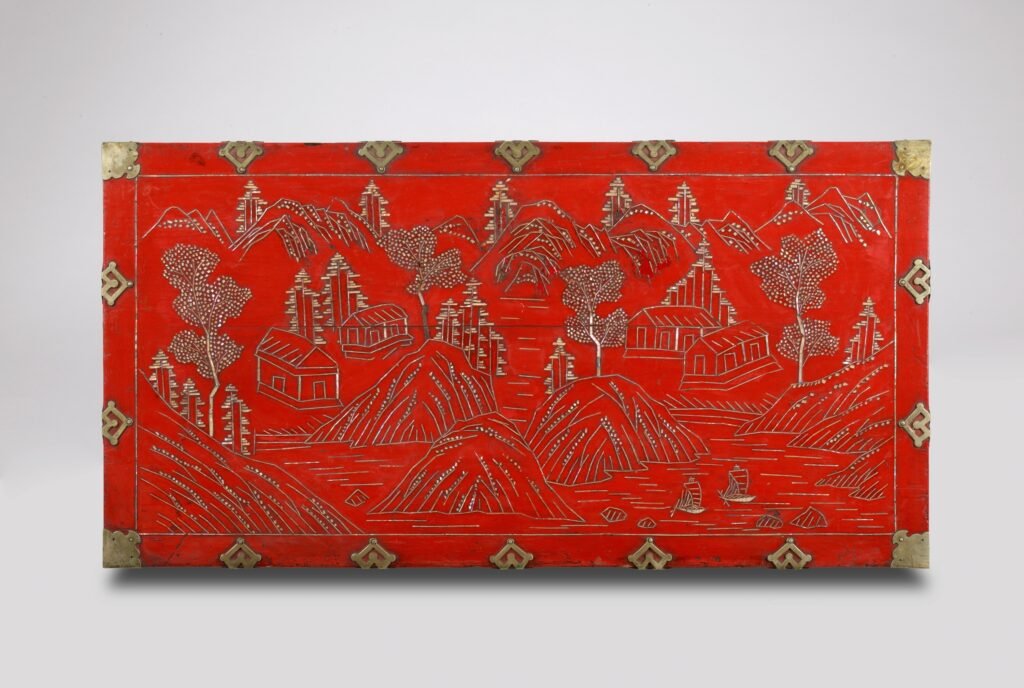
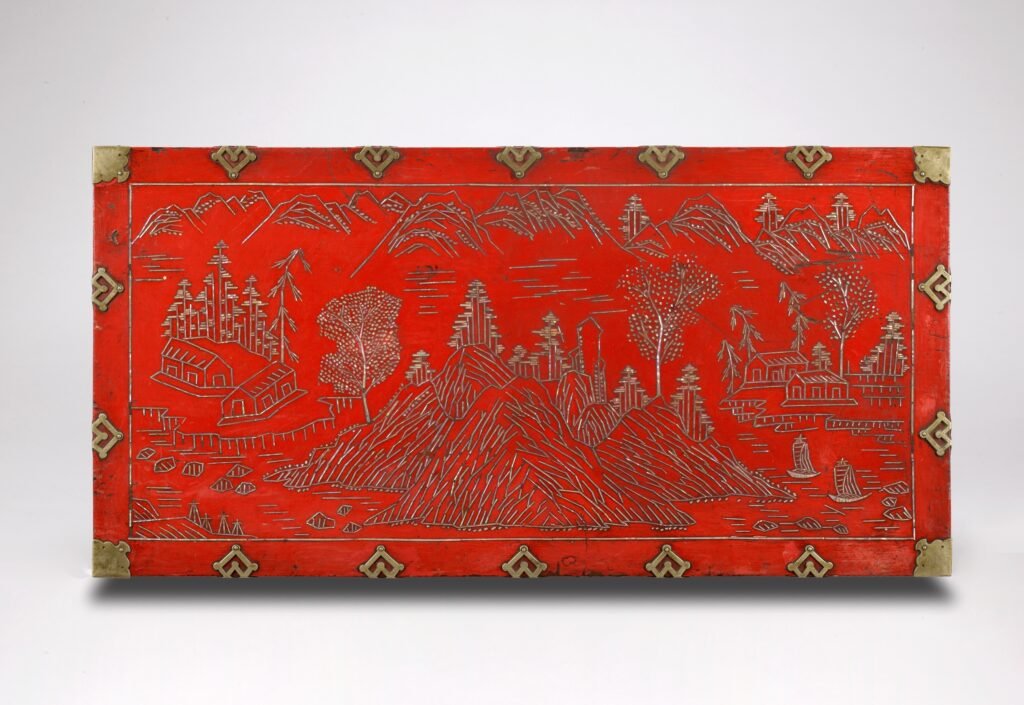
The prominent butterfly-shaped lock plates symbolize marital harmony and happiness.
Red-lacquered najeon chests of this kind reflect the refined tastes of the late Joseon aristocracy, incorporating technical influences from Qing China while maintaining distinct Korean aesthetics. Such pieces were most commonly produced in urban workshops in Seoul and Kaesong, centers known for creating high-quality lacquered ceremonial furniture for elite households.
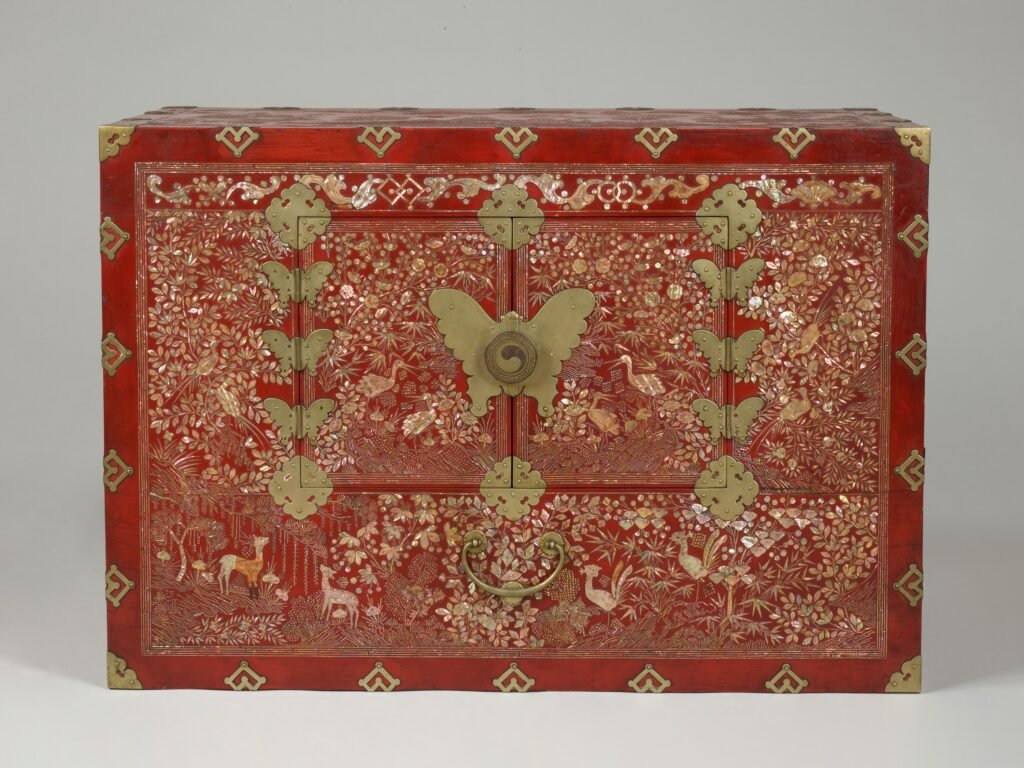
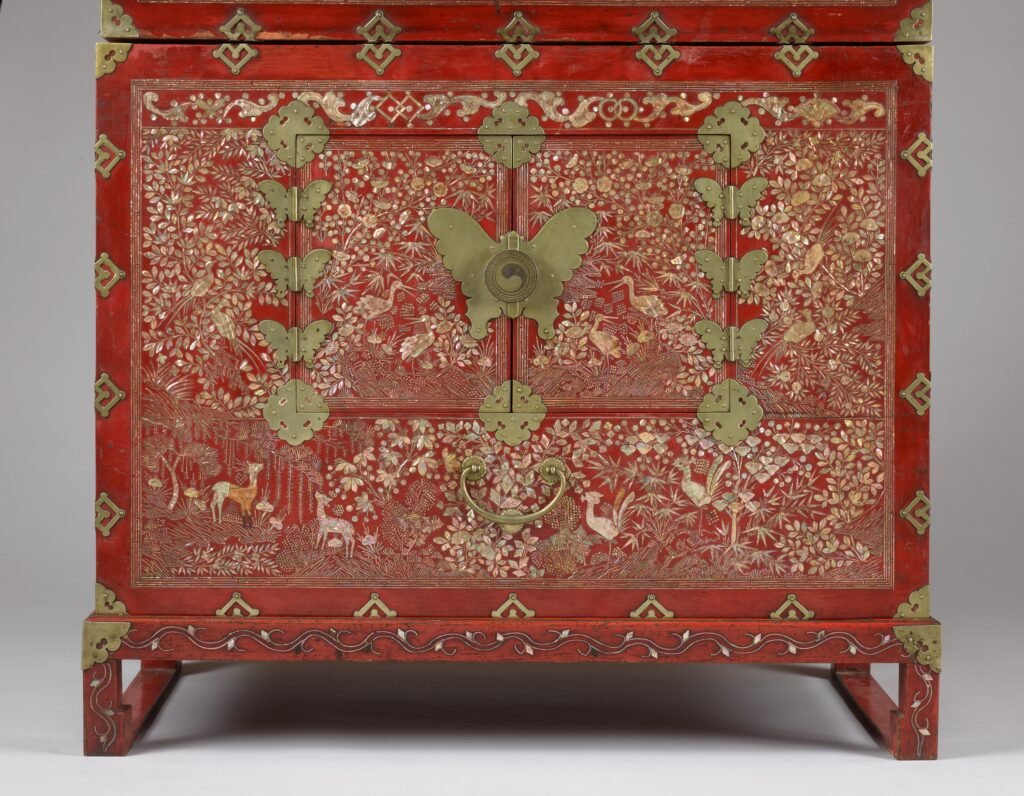
Differences of decorative technique between the Goryeo and the Joseon dynasties in Korea.
The mother-of-pearl decorative techniques evolved distinctively between the Goryeo and Joseon dynasties in Korea. During the Goryeo period (918-1392), mother-of-pearl inlay, known as “najeonchilgi,” was highly intricate and often used on lacquerware and wooden furniture. The artisans employed a meticulous process of cutting thin mother-of-pearl pieces into delicate shapes and embedding them into lacquer or wood, creating intricate designs often depicting natural motifs, landscapes, and patterns.
In contrast, the Joseon dynasty (1392-1897) saw a refinement of these techniques but with notable differences. Mother-of-pearl inlay, known as “chilseongmok,” became more prevalent on various objects, including furniture, chests, and decorative items. The Joseon artisans continued to use meticulous craftsmanship but focused more on geometric patterns, auspicious symbols, and Confucian motifs rather than the naturalistic themes favored in the Goryeo period.
Overall, while both dynasties valued the artistry and skill of mother-of-pearl inlay, their respective styles and motifs reflected the broader artistic and cultural shifts of their times.
The mother-of-pearl inlay techniques of the Goryeo and Joseon dynasties exhibit key differences in design motifs, craftsmanship, materials, and artistic intent. These variations reflect the cultural and ideological shifts between the two periods.
1. Motifs and Themes
Goryeo Dynasty (918–1392)
- Buddhist Influence: Since Buddhism was the dominant ideology, mother-of-pearl inlay often featured Buddhist symbols, lotus flowers, and celestial motifs.
- Nature-Inspired Patterns: Elaborate depictions of clouds, cranes, willows, phoenixes, peonies, and chrysanthemums were common.
- Complex, Flowing Designs: The inlays formed continuous, curvilinear patterns, creating a sense of movement and organic beauty.
Joseon Dynasty (1392–1897)
- Confucian Influence: With Confucianism replacing Buddhism as the state ideology, designs became more austere and restrained.
- Geometric and Symbolic Motifs: Straight lines, symmetrical patterns, auspicious symbols (such as longevity symbols, dragons, and Chinese characters like 壽 “longevity”), and simple floral patterns became prominent.
- Practicality Over Ornamentation: Unlike the lavish decoration of the Goryeo period, Joseon artisans preferred minimalistic yet elegant designs that reflected Confucian ideals of humility and restraint.
2. Craftsmanship and Techniques
Goryeo Dynasty
- Highly Detailed and Intricate: Artisans used extremely thin mother-of-pearl pieces cut into fine, detailed shapes.
- Layered Depth Effect: By using multiple layers of lacquer and polishing, they achieved a smooth, glass-like effect with rich depth and contrast.
- Use of Gold and Silver: Some pieces incorporated gold and silver threads, making them even more luxurious.
Joseon Dynasty
- Simplified Inlay Work: While still refined, the inlays were less elaborate, focusing on bold, well-defined patterns rather than intricate details.
- Stronger, Thicker Mother-of-Pearl: The pieces were often cut thicker and used in larger sections rather than in delicate, tiny fragments.
- Less Use of Gold and Silver: Joseon artisans avoided excessive luxury, in line with Confucian ideals, making the designs more subdued and natural-looking.
3. Material and Color Differences
Goryeo Dynasty
- Dark, Glossy Lacquer: Black lacquer was common, providing a striking contrast to the shimmering mother-of-pearl.
- Rich Color Variations: Some inlays had dyed mother-of-pearl, creating subtle color variations.
- Use of Imported Shells: Rare and expensive shells, sometimes imported, were used for their brighter iridescence.
Joseon Dynasty
- Natural Wood and Softer Colors: While black lacquer was still used, natural wood finishes became more common, creating a warmer, muted effect.
- Earthy and Subdued Aesthetic: The mother-of-pearl inlays often had a more natural, organic glow rather than strong iridescence.
4. Artistic and Cultural Intent
Goryeo Dynasty
- Luxury and Prestige: Najeonchilgi (mother-of-pearl lacquerware) was made for royalty and aristocrats, showcasing wealth and status.
- Spiritual and Aesthetic Appeal: The elaborate craftsmanship reflected Buddhist ideals of beauty and transcendence.
Joseon Dynasty
- Function and Simplicity: Furniture and objects with inlay were still beautifully crafted but more practical.
- Confucian Restraint: The shift to simpler, geometric patterns symbolized Confucian values of modesty, discipline, and ethical living.
Conclusion: Key Differences at a Glance
| Aspect | Goryeo Dynasty | Joseon Dynasty |
|---|---|---|
| Motifs | Natural, Buddhist, celestial themes | Geometric, Confucian, auspicious symbols |
| Craftsmanship | Extremely detailed, fine and intricate inlays | Bolder, more structured patterns |
| Materials | Thin mother-of-pearl, gold/silver inlay, imported shells | Thicker inlays, minimal metal use, local materials |
| Colors | High-contrast black lacquer, rich iridescence | Softer wood tones, restrained glow |
| Cultural Influence | Buddhist aesthetics, luxury and spirituality | Confucian ideals, practicality and simplicity |
Overall, the Goryeo dynasty’s najeonchilgi was a luxurious, intricate art form, while Joseon’s mother-of-pearl inlay became more practical and refined, focusing on simplicity and symbolism.
Final Comparison
| Feature | Goryeo Najeonchilgi | Joseon Najeonchilgi |
|---|---|---|
| Use | Luxury items for aristocracy & Buddhism | Functional furniture & household items |
| Motifs | Natural, flowing (phoenix, lotus, clouds) | Structured, symbolic (longevity, cranes, geometric) |
| Craftsmanship | Ultra-fine inlays, gold/silver accents | Thicker, simpler inlays, minimal decoration |
| Lacquer Style | Dark black lacquer, high contrast | Natural wood tones, softer finish |
| Cultural Influence | Buddhism, opulence, artistic expression | Confucianism, practicality, moral restraint |
Some samples
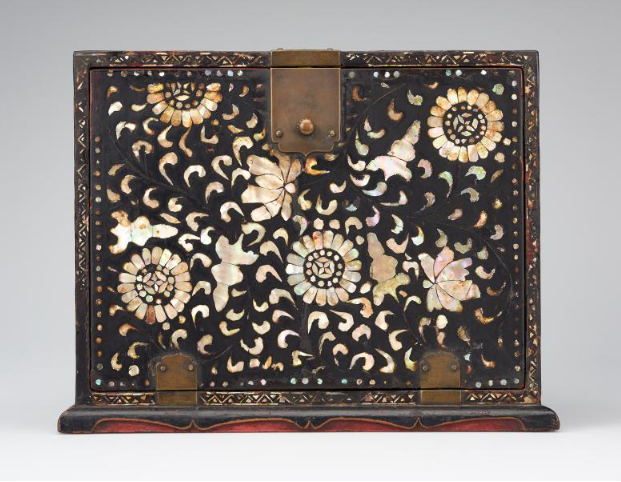

The box from the Joseon dynasty (Photo left) makes an interesting comparison with the trefoil-shaped covered box from the Goryeo dynasty displayed on the right photo. The two boxes have similar decorative motifs—chrysanthemums—but the techniques and approaches to the materials, especially mother-of-pearl, are different. In this Joseon-dynasty work, mother-of-pearl is the main design material; most of the areas within the flowers and leaves are solely inlaid with mother-of-pearl.
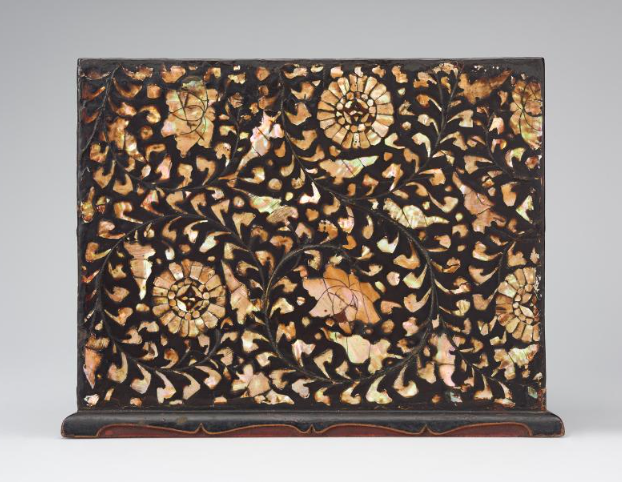
In contrast, on the trefoil-shaped covered box, Goryeo artisans included other materials, such as tortoiseshell painted on the reverse. The use of metal wire was confined to the branches in the Joseon dynasty box, unlike most Goryeo lacquerwares.

While Goryeo mother-of-pearl lacquerwares were adorned with densely patterned decorative motifs, Joseon lacquerware motifs became more sparsely patterned, more naturalistic, and surrounded by negative space. Joseon artisans put more emphasis on highlighting the distinct characteristics of the raw material, mother-of-pearl.
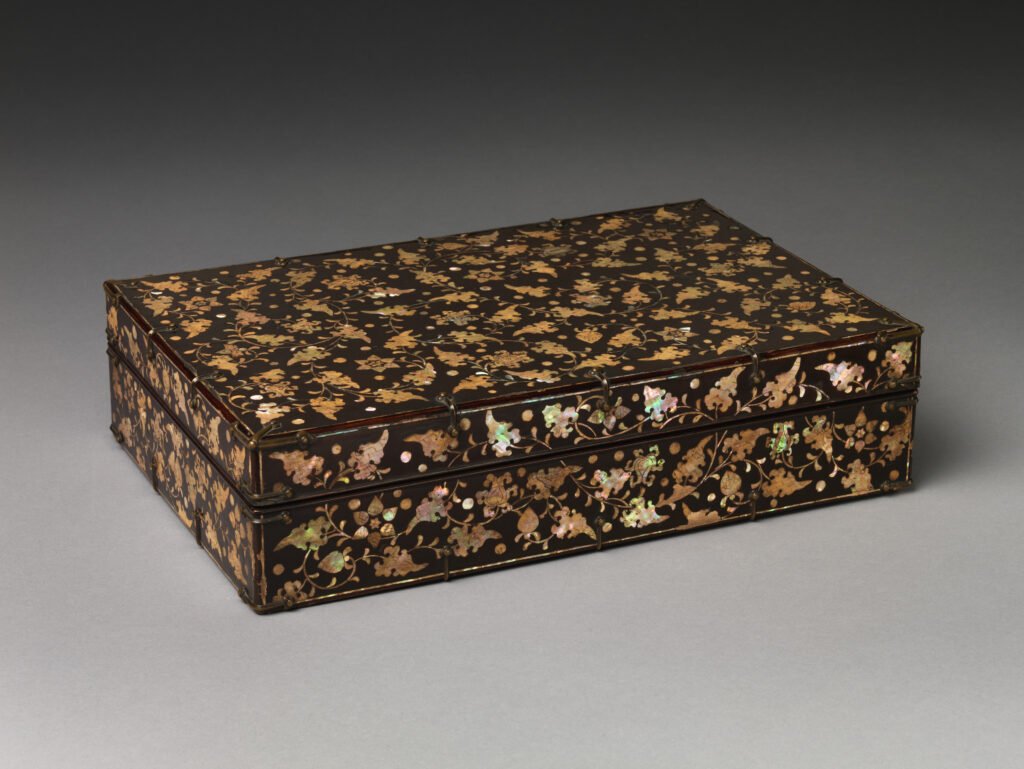
15th–16th century
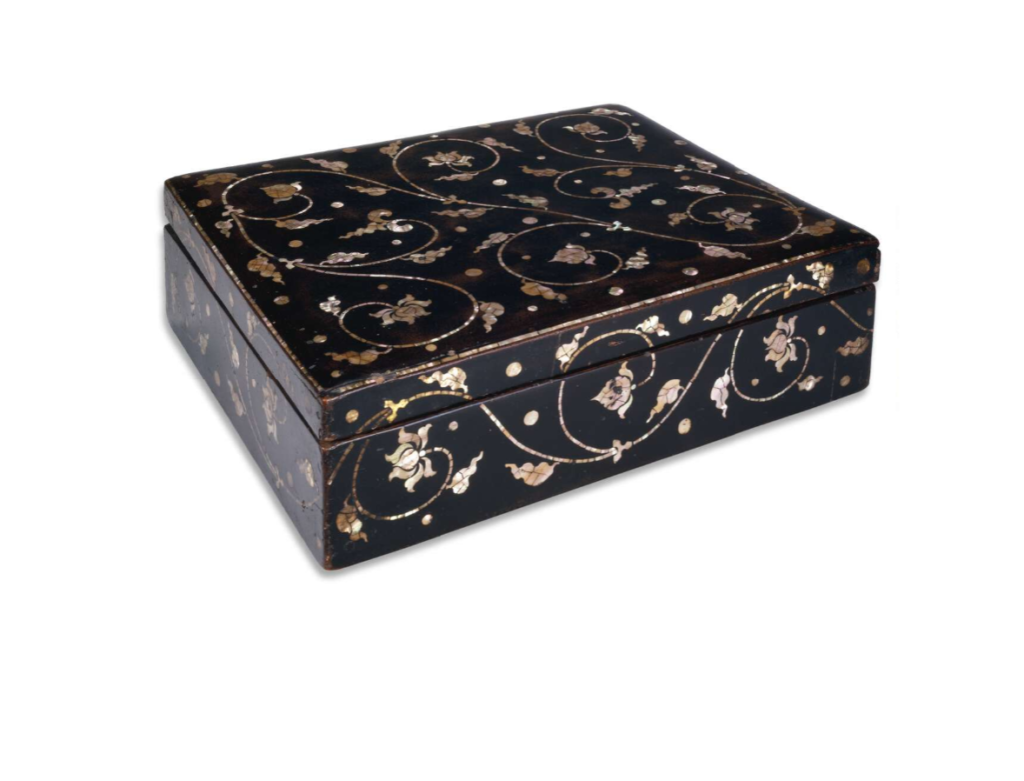
Box with inlaid decoration of peony scrolls in mother-of-pearl. JOSEON – 17th-18th century
On the left, A rare example of early Joseon lacquer, the box’s ornate design of peony blossoms and acanthus-like leaves illustrates the expansion of sophisticated Goryeo-dynasty techniques and traditions. Collection: The MET, Metropolitan Museum, New York. USA.
On the right, A predominant feature of Joseon lacquerware is the use of scrolling vines or flowers inlaid in mother-of-pearl without the aid of metal wire that was used in the previous Goryeo period. The typically relaxed design of the scrolling vine patterns, as seen here, which left large areas of black lacquer, had a profound influence on subsequent Japanese inlaid lacquerware. Collection: The British Museum.
Late Joseon artifacts – 19th century.
The photos below illustrate late Joseon dynasty pieces (19th century). The decor is simpler and more pure, with less use of mother-of-pearl, revealing empty spaces covered only with lacquer.
Mother-of-pearl, plum, bird, pine, crane, and auspicious beast patterned shell box. Joseon – 19th century. Horim Museum, Seoul, Korea.
This is a chest for storing various treasures. Unlike ordinary chests, this chest has two vertical sliding doors, one on each side. The part where the top and the sliding doors meet has a round hidden lock decorated with a fish pattern and a flower pattern, and a mandoo-shaped lock on the corner. The sliding door has a Chinese character for “囍”, and the top has a cloud and crane pattern on both sides with the Chinese character for “囍” in mother-of-pearl. On both sides, plum blossoms, turtles, fish, pine cranes, tigers, water lilies, and deer are expressed to create a sense of space.
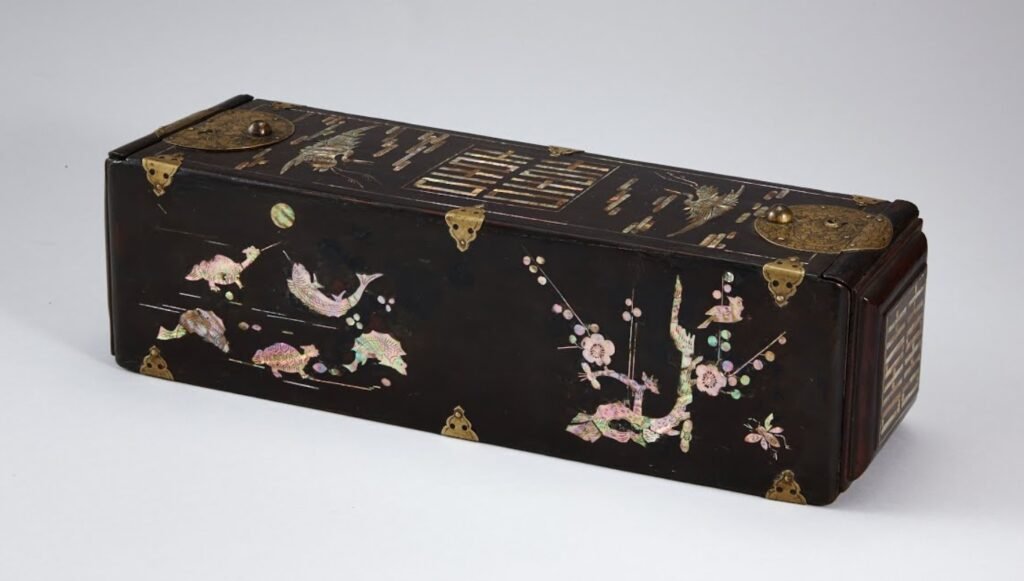
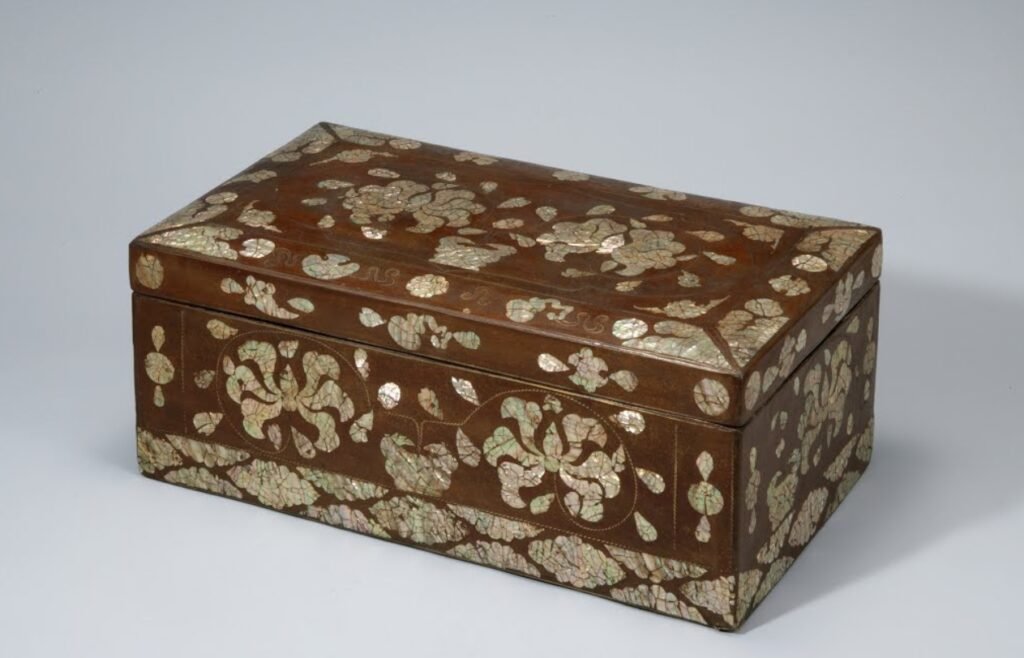
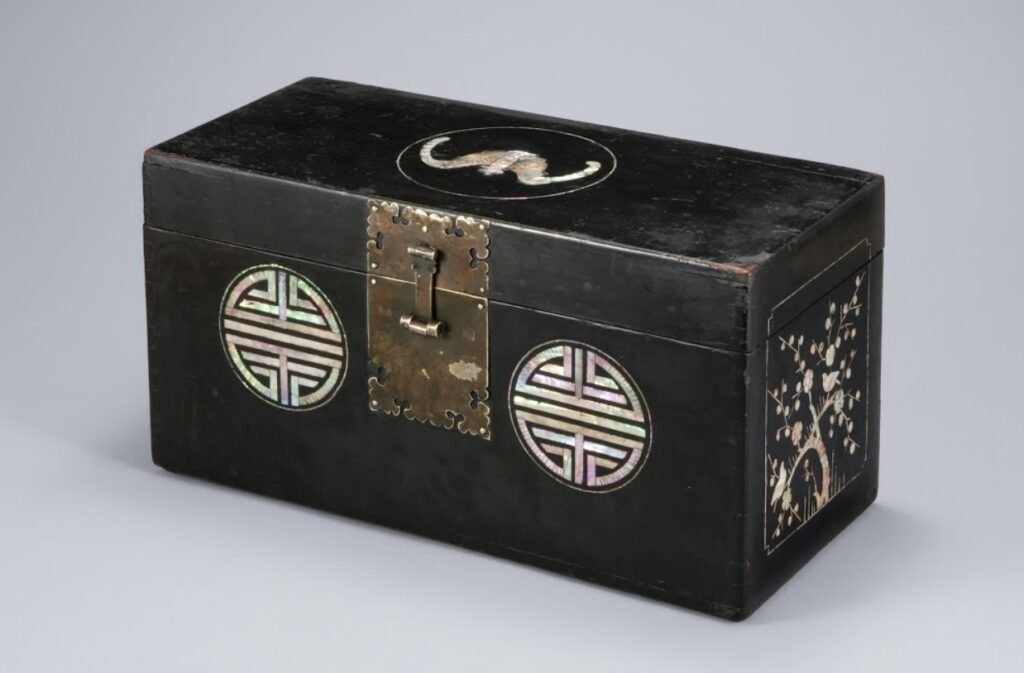
Joseon – 19th century.
Collection: Horim Museum, Seoul, Korea.
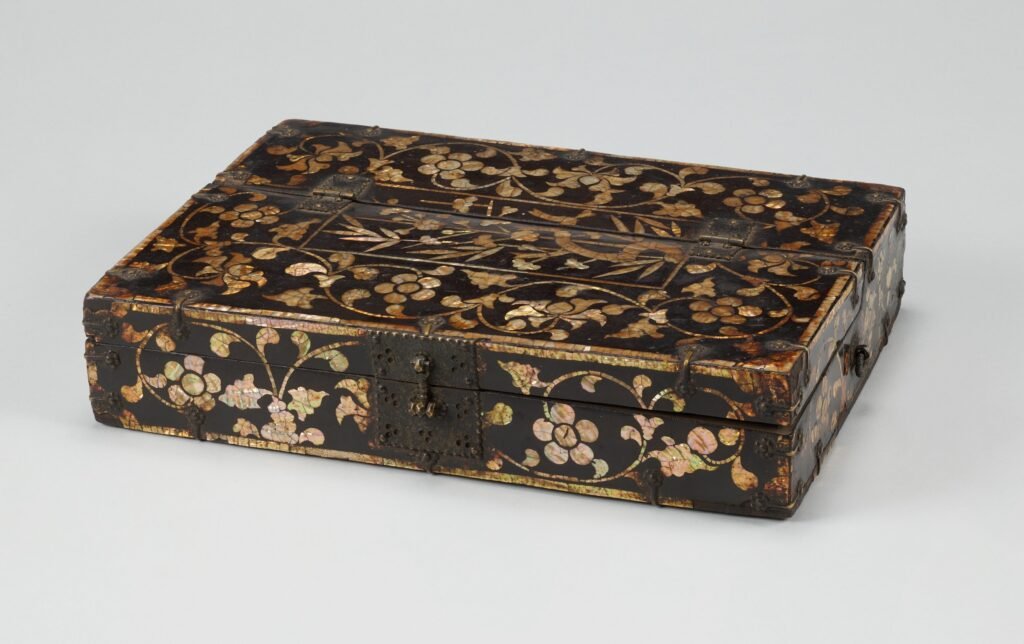
Collection: National Museum of Korea, Seoul.
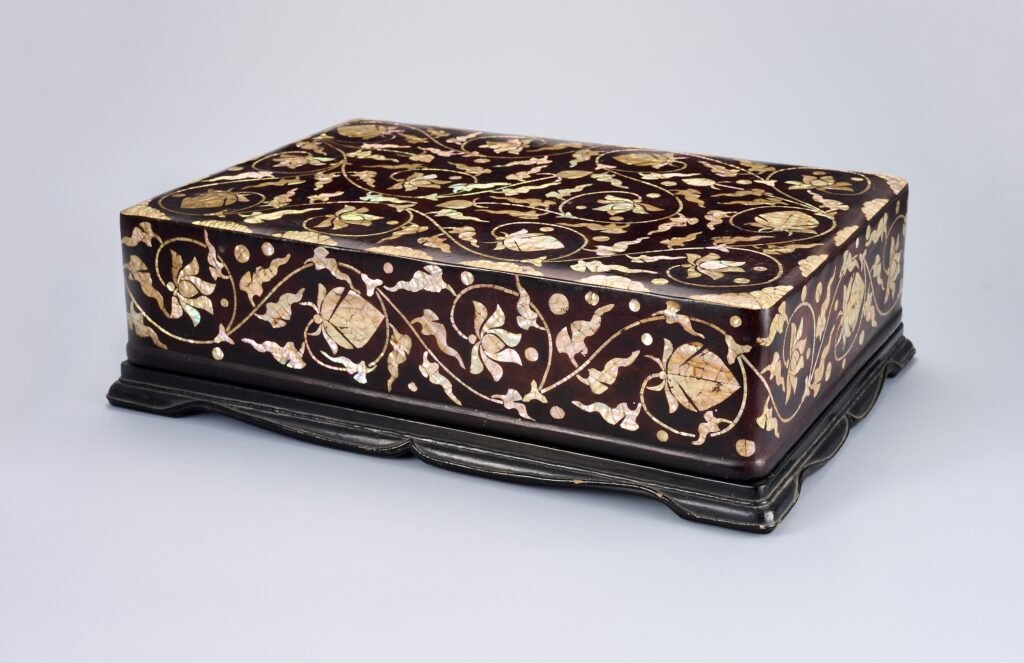
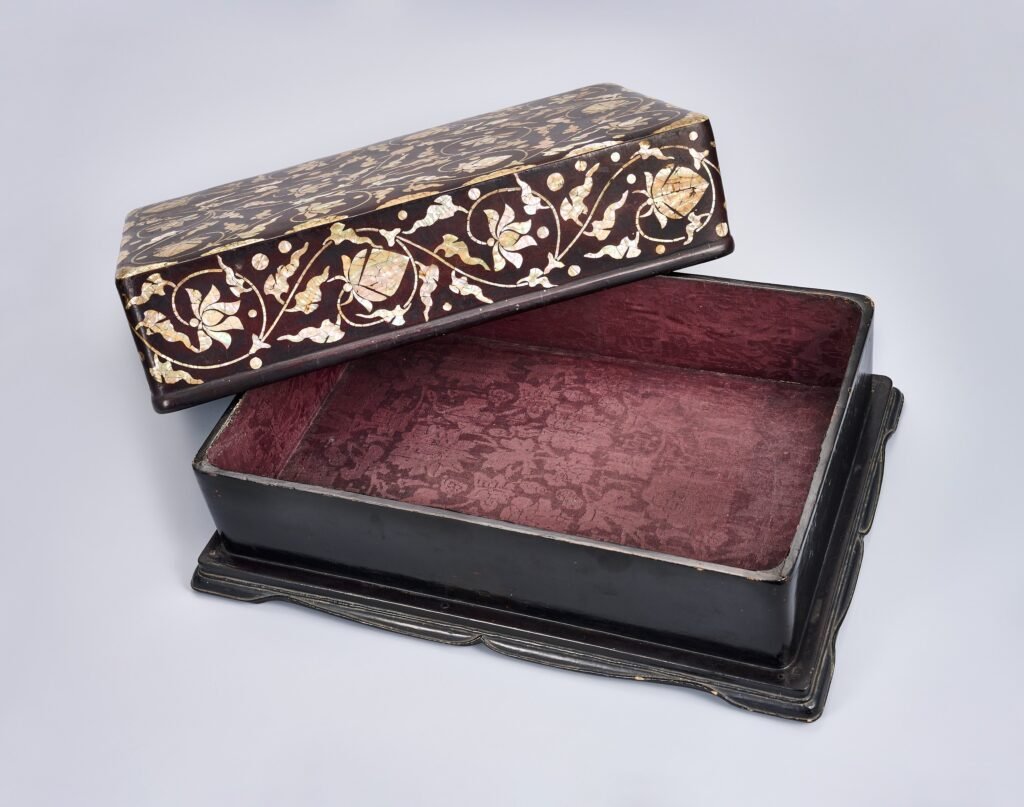

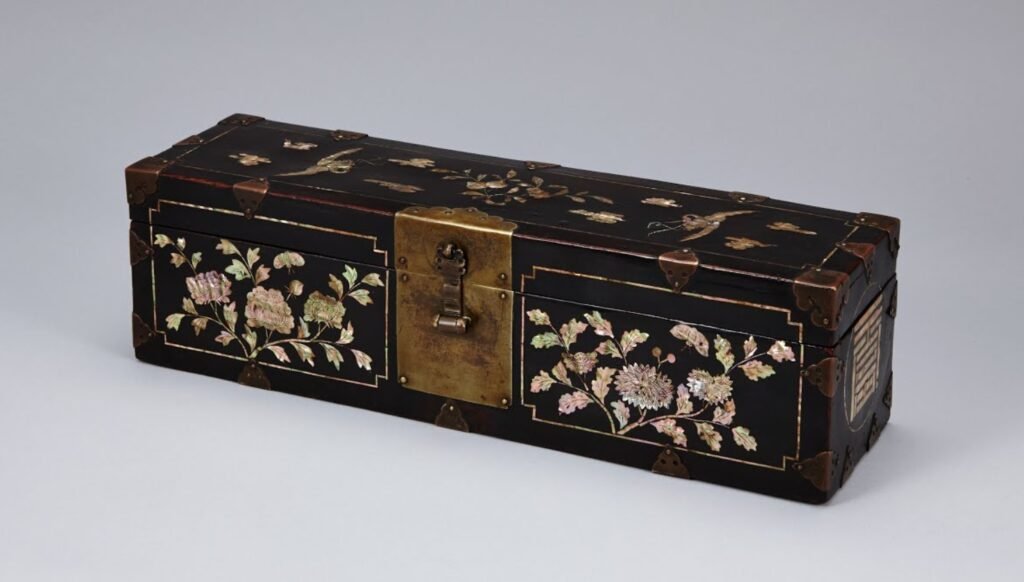

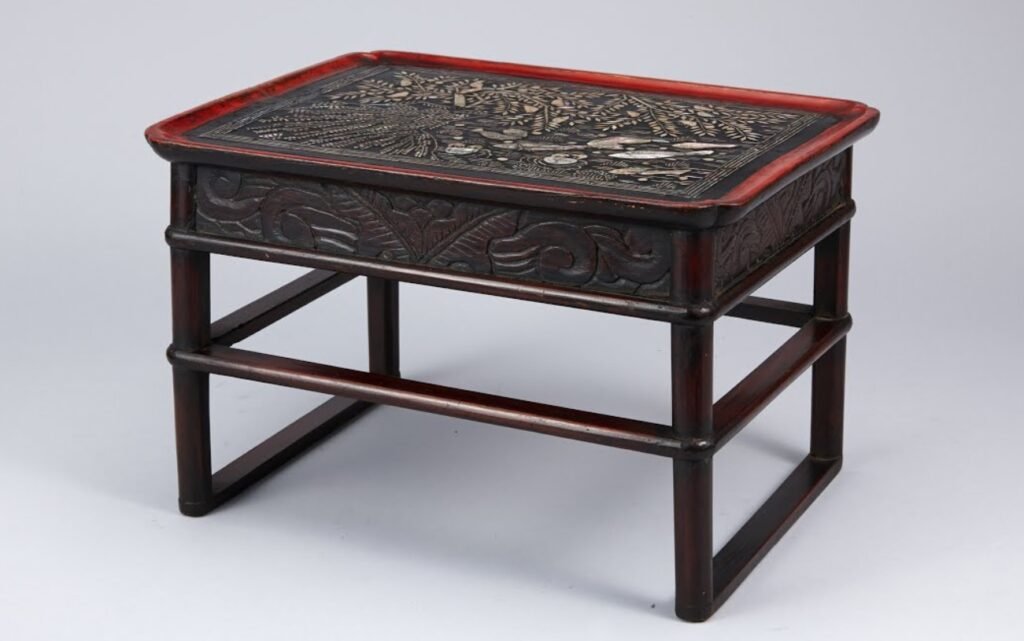

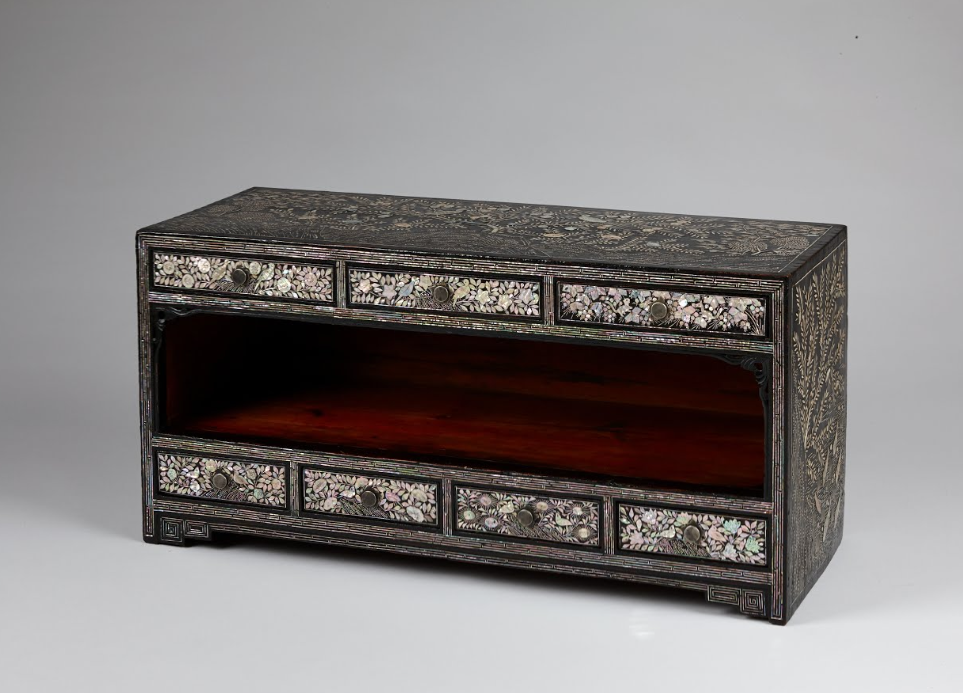
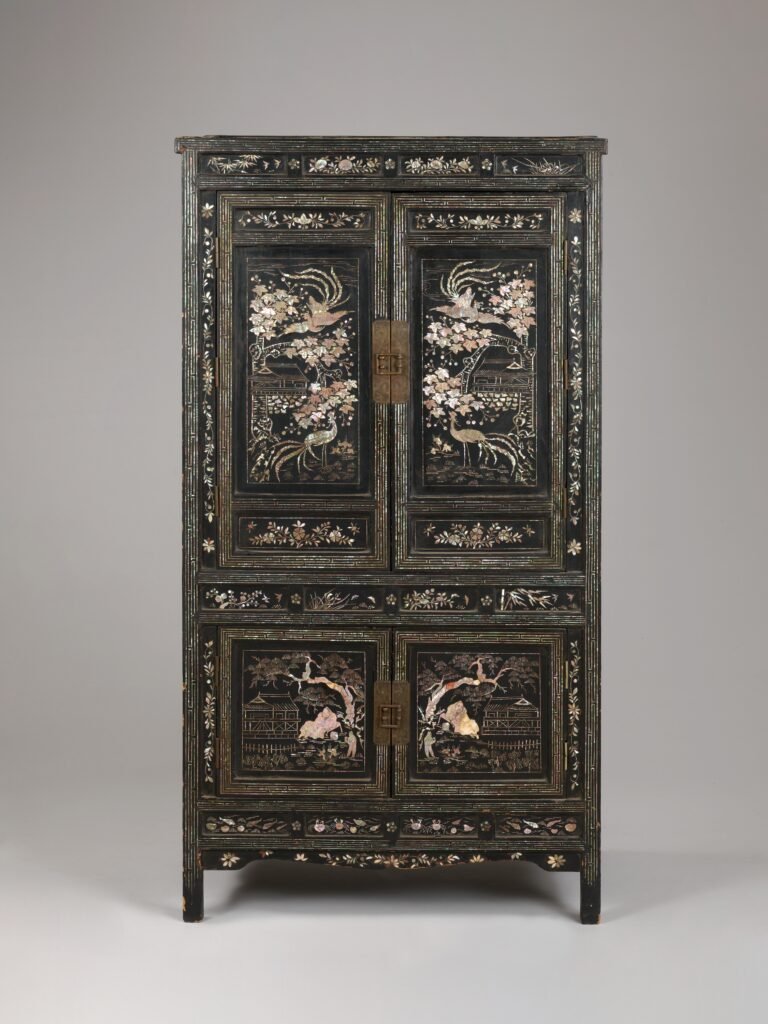
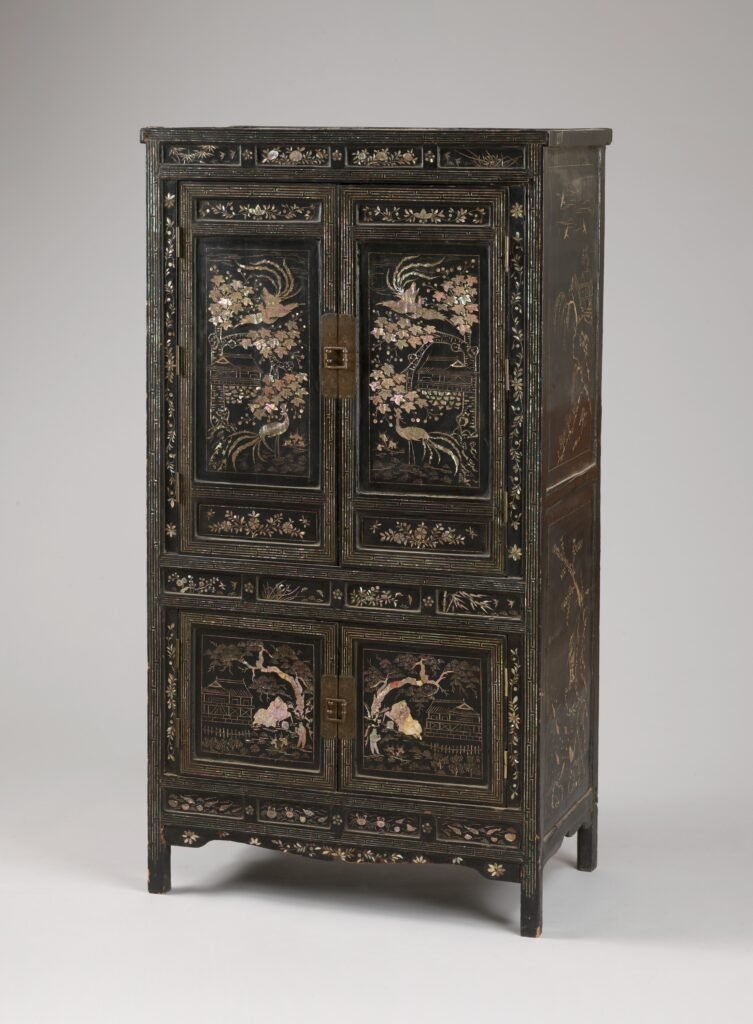
Photos above (2). Korean wardrobe cabinet decorated with mother-of-pearl inlay.
This Korean mother-of-pearl–inlaid cabinet, often classified as a jang or multi-section wardrobe, is crafted in black lacquer with exceptionally fine najeonchilgi and built in two tiers, each with double doors secured by traditional Korean brass hardware. Its decoration reflects late Joseon to early 20th-century high-quality lacquer work: the upper doors show phoenixes perched among blossoming plum or cherry trees, made with large shell fragments that create depth and shimmering color, all framed by dense floral inlay; the lower panels depict garden or pavilion scenes with trees, rocks, and foliage in shaded shell inlay typical of refined landscape compositions. The chest stands on slender straight legs and every surface—front, sides, frame, and apron—is densely covered with floral, vine, and geometric motifs, complemented by square, minimalist Korean brass fittings. Overall, it is a richly decorated luxury cabinet whose phoenix imagery, pavilions, and elaborate mother-of-pearl work suggest it was made for an elite household in the late 19th to early 20th century.
H. 145cm, W. 76cm, D. 44cm.
Collection: National Museum of Korea, Seoul.
APPENDIX:
Brilliant Hue. Mother-of-pearl of the Joseon dynasty. Exhibition at the Horim Museum (2015) in Seoul. Highlight of Joseon dynasty woodworking centered around lacquerware inlay with mother-of-pearl.

